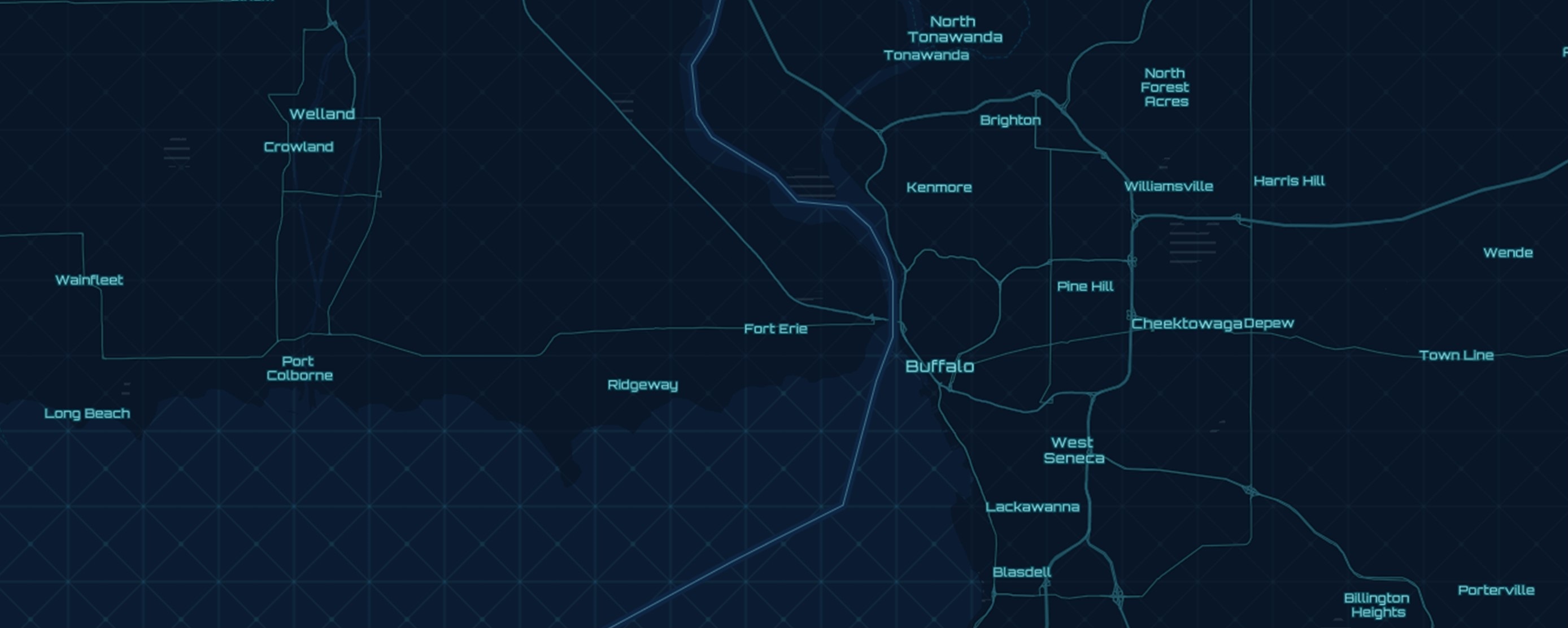
About Me

My name is Yingjie Hu. I am an Associate Professor in the Department of Geography at the University at Buffalo (UB). I am also
an Adjunct Professor in the Department of Computer Science and Engineering, and an Affiliate Faculty of the UB Center for Geological and Climate Hazards and the UB AI and Data Science Institute.
My major research areas are geospatial artificial intelligence (GeoAI), geographic information science, and disaster management. I lead the GeoAI Lab@UB,
a research group focusing on integrating geospatial data, GIS, and AI methods to understand human-environment interactions and to address challenges related to natural disasters, such as hurricanes, wildfires, and winter storms. Together, I hope the research of my group contributes to a more sustainable future.
Prospective Students: If you are interested in working with me, please check this Opportunities page to see whether there is an opening.
Research Interests
- GeoAI
- Disaster Management
- Natural Hazards
- Community Resilience
- Human-Environment Interactions
- GIScience
- Spatial Data Science
- Remote Sensing
- Sustainability
Education
- 9/2011 - 6/2016: Ph.D. in Geography (minor in AI), University of California, Santa Babara, USA.
- 9/2008 - 6/2011: M.S. in Cartography and GIS, East China Normal University, Shanghai, China.
- 9/2004 - 6/2008: B.S. in Cartography and GIS, East China Normal University, Shanghai, China.
Publications
(Authors with an underscore are my advisees)Peer-reviewed Journal Articles:
- Zhou, R.Z., Hu, Y., Sun, K., Muldoon, R., Clark, S., & Joseph, K., (2025): Explainable GeoAI and statistical analysis reveal complementary insights about disparities of 311 help requests during the 2022 Buffalo blizzard. International Journal of Disaster Risk Reduction, 105635.
- Sun, K., Hu, Y., Joseph, K., & Zhou, R.Z. (2025): GALLOC: A GeoAnnotator for Labeling LOCation descriptions from disaster-related text messages. International Journal of Geographical Information Science, 1-31.
- Li, W., Arundel, S., Gao, S., Goodchild, M., Hu, Y., Wang, S., & Zipf, A. (2024): GeoAI for Science and the Science of GeoAI. Journal of Spatial Information Science, 29, 1-17.
- Sun, K., Zhou, R.Z., Kim, J., & Hu, Y., (2024): PyGRF: An improved Python Geographical Random Forest model and case studies in public health and natural disasters. Transactions in GIS, 28(7), 2476-2491.
- Zhou, R.Z., Hu, Y., Zou, L., Cai, H. & Zhou, B. (2024): Understanding the disparate impacts of the 2021 Texas winter storm and power outages through mobile phone location data and nighttime light images. International Journal of Disaster Risk Reduction, 104339.
- Hu, Y., Goodchild, M., Zhu, A.X., Yuan, M., Aydin, O., Bhaduri, B., Gao, S., Li, W., Lunga, D., & Newsam, S. (2024): A five-year milestone: reflections on advances and limitations in GeoAI research. Annals of GIS, 30(1), 1-14.
- Mai, G., Huang, W., Sun, J., Song, S., Mishra, D., Liu, N., Gao, S., Liu, T., Cong, G., Hu, Y., & Cundy, C., (2024): On the opportunities and challenges of foundation models for GeoAI. ACM Transactions on Spatial Algorithms and Systems, 10(2), Article 11.
- Tirabassi, J.N., Wang, J., Zhou, R.Z., & Hu, Y. (2024): Human mobility data demonstrates increase in park visitation since start of COVID-19 pandemic in Buffalo, New York. Preventive Medicine Reports, 102650.
- Magid, H.S.A., Desjardins, M.R., & Hu, Y. (2024): Opportunities and shortcomings of AI for spatial epidemiology and health disparities research on aging and the life course. Health & Place, 89, p.103323.
- Hu, Y., Mai, G., Cundy, C., Choi, K., Lao, N., Liu, W., Lakhanpal, G., Zhou, R.Z., & Joseph, K. (2023): Geo-knowledge-guided GPT models improve the extraction of location descriptions from disaster-related social media messages. International Journal of Geographical Information Science, 37(11), 2289-2318.
- Sun, K., Hu, Y., Ma, Y., Zhou, R.Z., & Zhu, Y. (2023): Conflating point of interest (POI) data: A systematic review of matching methods. Computers, Environment and Urban Systems, 103, 101977.
- Hu, X., Zhou, Z., Li, H., Hu, Y., Gu, F., Kersten, J., Fan, H. & Klan, F., (2023): Location reference recognition from texts: A survey and comparison. ACM Computing Surveys, 56(5), article 112, 1–37.
- Zhou, B., Zou, L., Hu, Y., Qiang, Y., & Goldberg, D. (2023): TopoBERT: a plug and play toponym recognition module harnessing fine-tuned BERT. International Journal of Digital Earth, 16(1), 3045-3063.
- Zhou, R.Z., Hu, Y., Tirabassi, J., Ma, Y., & Xu, Z. (2022): Deriving neighborhood-level diet and physical activity measurements from anonymized mobile phone location data for enhancing obesity estimation. International Journal of Health Geographics, 21(1), 1-18.
- Ma, Y., Hu, Y., Moncrieff, G.R., Slingsby, J.A., Wilson, A.M., Maitner, B., & Zhou, R.Z. (2022): Forecasting vegetation dynamics in an open ecosystem by integrating deep learning and environmental variables. International Journal of Applied Earth Observation and Geoinformation, 114, 103060.
- Mai, G., Hu, Y., Gao, S., Cai, L., Martins, B., Scholz, J., Gao, J., & Janowicz, J. (2022): Symbolic and subsymbolic GeoAI: Geospatial knowledge graphs and spatially explicit machine learning. Transactions in GIS, 26, 3118-3124.
- Lunga, D., Hu, Y., Newsam, S., Gao, S., Martins, B., Yang, L., & Deng, X. (2022): GeoAI at ACM SIGSPATIAL: The new frontier of geospatial artificial intelligence research. SIGSPATIAL Special, 13(1-3), 21-32.
- Psyllidis, A., Gao, S., Hu, Y., Kim, E.K., McKenzie, G., Purves, R., Yuan, M. & Andris, C. (2022): Points of Interest (POI): a commentary on the state of the art, challenges, and prospects for the future. Computational Urban Science, 2(1), 1-13.
- Chang, T., Hu, Y., Taylor, D., & Quigley, B.M. (2022): The role of alcohol outlet visits derived from mobile phone location data in enhancing domestic violence prediction at the neighborhood level. Health & Place, 73, 102736.
- Hu, Y., Gui, Z., Wang, J., & Li, M. (2022): Enriching the metadata of map images: a deep learning approach with GIS-based data augmentation. International Journal of Geographical Information Science, 36(4), 799–821.
- Mai, G., Janowicz, K., Hu, Y., Gao, S., Yan, B., Zhu, R., Cai, L., & Lao, N. (2022): A review of location encoding for GeoAI: methods and application. International Journal of Geographical Information Science, 36(4), 639–673.
- Hu, Y., Quigley, B.M. & Taylor, D., (2021): Human mobility data and machine learning reveal geographic differences in alcohol sales and alcohol outlet visits across US states during COVID-19. PlOS ONE, 16(12), p.e0255757.
- Wilson, J., Butler, K., Gao, S., Hu, Y., Li, W., & Wright, D. (2021): A five-star guide for achieving replicability and reproducibility when working with GIS software and algorithms. Annals of the American Association of Geographers, 111(5), 1311-1317.
- Sun, K., Hu, Y., Song, J., & Zhu, Y. (2021): Aligning geographic entities from historical maps for building knowledge graphs. International Journal of Geographical Information Science, 35(10), 2077-2106.
- Hu, Y. & Wang, R.Q. (2020): Understanding the removal of precise geotagging in tweets. Nature Human Behaviour, 4, 1219–1221.
- Wang, J., Hu, Y., & Joseph, K. (2020): NeuroTPR: A Neuro-net ToPonym Recognition model for extracting locations from social media messages. Transactions in GIS, 24(3), 719-735.
- Wang, R.Q., Hu, Y., Zhou, Z. & Yang, K., (2020): Tracking flooding phase transitions and establishing a passive hotline with AI-enabled social media data. IEEE Access Journal, 8(1), 103395-103404.
- Andris, C., Ayers, E., Grossner, K., Hu, Y., Hart, K., Thatcher, J., Tally Jr, R.T. & Giordano, A. (2020): Towards geospatial humanities: reflections from two panels. International Journal of Humanities and Arts Computing, 14(1-2), 6-26.
- Janowicz, K., Gao, S., McKenzie, G., Hu, Y. & Bhaduri, B. (2020): GeoAI: Spatially explicit artificial intelligence techniques for geographic knowledge discovery and beyond, International Journal of Geographic Information Science, 34(4), 625-636.
- Wang, J. & Hu, Y. (2019): Enhancing spatial and textual analysis with EUPEG: an extensible and unified platform for evaluating geoparsers. Transactions in GIS, 23(6), 1393-1419.
- Hu, Y., Gao, S., Lunga, D., Li, W., Newsam, S. & Bhaduri, B. (2019): GeoAI at ACM SIGSPATIAL: progress, challenges, and future directions. SIGSPATIAL Special, 11(2), 5-15.
- Hu, Y., Deng, C., & Zhou, Z. (2019): A semantic and sentiment analysis on online neighborhood reviews for understanding the perceptions of people toward their living environment. Annals of the American Association of Geographers, 109(4), 1052-1073.
- Hu, Y. (2018): Geo-text data and data-driven geospatial semantics. Geography Compass, 12(11), e12404.
- Hu, Y., Mao, H., & McKenzie, G. (2018): A natural language processing and geospatial clustering framework for harvesting local place names from geotagged housing advertisements. International Journal of Geographical Information Science, 33(4), 714-738.
- McKenzie, G., Liu, Z., Hu, Y., & Lee, M. (2018): Identifying urban neighborhood names through user-contributed online property listings, ISPRS International Journal of Geo-Information, 7(10), 388-411.
- Mai, G., Janowicz, K., Hu, Y., & Gao, S. (2018): ADCN: an anisotropic density-based clustering algorithm for discovering spatial point patterns with noise, Transactions in GIS, 22(1), 348-369.
- Gao, S., Janowicz, K., Montello, D., Hu, Y., Yang, J.-A., McKenzie, G., Ju, Y., Gong, L. Adams, B., & Yan, B. (2017): A data-synthesis-driven method for detecting and extracting vague cognitive regions. International Journal of Geographical Information Science, 31(6), 1245-1271.
- Hu, Y., Ye, X., & Shaw, S.-L. (2017): Extracting and analyzing semantic relatedness between cities using news articles. International Journal of Geographical Information Science, 31(12), 2427-2451.
- Hu, Y., Janowicz, K., & Couclelis, H. (2017): Prioritizing disaster mapping tasks for online volunteers based on information value theory. Geographical Analysis, 49, 175–198.
- Zhu, R., Hu, Y., Janowicz, K., & McKenzie, G. (2016): Spatial signatures for geographic feature types: examining gazetteer ontologies using spatial statistics. Transactions in GIS, 20(3), 333-355.
- Hu, Y., Janowicz, K., & Chen, Y. (2016): Task-oriented information value measurement based on space-time prisms, International Journal of Geographical Information Science, 30(6), 1228-1249.
- Hu, Y., Gao, S., Janowicz, K., Yu, B., Li, W., & Prasad, S. (2015): Extracting and understanding urban areas of interest using geotagged photos, Computers, Environment and Urban Systems, 54, 240-254.
- Hu, Y., Janowicz, K., Prasad, S., & Gao S. (2015): Metadata topic harmonization and semantic search for Linked-Data-driven geoportals: a case study using ArcGIS Online, Transactions in GIS, 19(3), 398-416.
- Hu, Y., Lv, Z., Wu, J., Janowicz, K., Zhao, X., & Yu, B. (2015): A multistage collaborative 3D GIS to support public participation, International Journal of Digital Earth, 8(3), 212- 234.
- Chen, Z., Yu, B., Hu, Y., Huang, C., Shi, K., & Wu, J. (2015): Estimating house vacancy rate in metropolitan areas using NPP-VIIRS nighttime light composite data, IEEE Journal of Selected Topics in Applied Earth Observations and Remote Sensing, 8(5), 2188-2197.
- Shi, K., Yu, B., Hu, Y., Huang, C., Chen, Y., Huang, Y., Chen, Z., & Wu J. (2015): Modeling and mapping total freight traffic in China using NPP-VIIRS nighttime light composite data, GIScience & Remote Sensing, 52(3), 274-289.
- Yu, B., Shi, K., Hu, Y., Huang, C., Chen, Z., & Wu, J. (2015): Poverty evaluation using NPP-VIIRS nighttime light composite data at the county level in China, IEEE Journal of Selected Topics in Applied Earth Observations and Remote Sensing, 8(3), 1217-1229.
- McKenzie, G., Janowicz, K., Gao, S., Yang, J., & Hu, Y. (2014): POI Pulse: a multi-granular, semantic signature–based information observatory for the interactive visualization of big geosocial data, Cartographica: The International Journal for Geographic Information and Geovisualization, 50(2), 71-85.
- Shi, K., Yu, B., Huang, Y., Hu, Y., Yin, B., Chen, Z., Chen, L., & Wu, L. (2014): Evaluating the ability of NPP-VIIRS nighttime light data to estimate the gross domestic product and the electric power consumption of China at multiple scales: a comparison with DMSP-OLS data, Remote Sensing, 6 (2), 1705-1724.
- Chen, Z., Yu, B., Huang, Y., Hu, Y., Lin, H., & Wu, J. (2013): Validation of total ozone column derived from OMPS using ground-based spectroradiometer measurements, Remote Sensing Letters, 4 (10), 937-945.
- Lin, H., Yu, B., Chen, Z., Hu, Y., Huang, Y., Wu, J., Wu, B., & Ge, R. (2013): A geospatial web portal for sharing and analyzing greenhouse gas data derived from satellite remote sensing images, Frontiers of Earth Science, 7 (3), 295-309.
- Yu, B., Liu, H., Wu, J., Hu, Y., & Zhang, L. (2010): Automated derivation of urban building density information using airborne LiDAR data and object-based method, Landscape and Urban Planning, 98 (3-4), 210-219.
- Hu, Y. & Wu, J. (2010): Design of enterprise three-dimensional GIS based on skyline and ExtJS, Science of Surveying and Mapping, 35 (6), 247-249. (in Chinese)
- Li, J., Wu, J., & Hu, Y. (2009): Development of three-dimensional urban scanning system using TerraExplorer Pro, Computer Technology and Development, 6, 66-68. (in Chinese)
Edited Book:
- Gao, S., Hu, Y., & Li, W. (2023): Handbook of Geospatial Artificial Intelligence, Taylor & Francis Group. [Book Preview]
Peer-reviewed Book Chapters:
- Sun, K., Hu, Y., Lakhanpal, G., & Zhou, R.Z. (2023): Spatial cross-validation for GeoAI, In S. Gao, Y. Hu, and W. Li (Eds), Handbook of Geospatial Artificial Intelligence, Taylor & Francis Group.
- Zhu, D. & Hu, Y. (2022): Artificial Intelligence, In L. Lees and D. Demeritt (Eds), Concise Encyclopedia of Human Geography, Edward Elgar Publishing.
- Hu, Y. & Adams, B. (2021): Harvesting big geospatial data from natural language texts. In M. Werner and Y.-Y. Chiang (Eds), Handbook of Big Geospatial Data, Springer.
- Yan, B., Mai, G., Hu, Y., & Janowicz, K. (2021): Harnessing heterogeneous big geospatial data. In M. Werner and Y.-Y. Chiang (Eds), Handbook of Big Geospatial Data, Springer.
- Gao, S., Li, M., Rao, J., Mai, G., Prestby, T., Marks, J., & Hu, Y. (2021): Automatic urban road network extraction from massive GPS trajectories of taxis. In M. Werner and Y.-Y. Chiang (Eds), Handbook of Big Geospatial Data, Springer.
- Hu, Y., Li, W., Wright, D., Aydin, O., Wilson, D., Maher, O, & Raad, M. (2019): Artificial intelligence approaches. In J. P. Wilson (Eds), The Geographic Information Science & Technology Body of Knowledge, University Consortium for Geographic Information Science.
- Hu, Y. (2018): Geospatial semantics. In B. Huang, T. J. Cova, & M. Tsou et al. (Eds), Comprehensive Geographic Information Systems, also included in Elsevier’s Reference Module in Earth Systems and Environmental Sciences, 1, 80-94, Elsevier.
- Janowicz, K., McKenzie, G., Hu, Y., Zhu, R., & Gao, S. (2018): Using semantic signatures for social sensing in urban environments, In C. Antoniou, L. Dimitriou, & F. Pereira (Eds), Mobility Patterns, Big Data and Transport Analytics: Tools and Applications for Modeling, 31-54, Elsevier.
- Gao, S., Chen, H., Luo, W., Hu, Y., & Ye, X. (2018): Spatio-temporal-network visualization for exploring human movements and interactions in physical and virtual spaces. In S.L. Shaw & D. Sui (Eds), Human Dynamics Research in Smart and Connected Communities, 67-80, Springer.
- Hu, Y. & Li, W. (2017): Spatial data infrastructures. In J. P. Wilson (Eds), The Geographic Information Science & Technology Body of Knowledge, University Consortium for Geographic Information Science.
- Hu, Y. & Janowicz, K. (2016): The semantic trajectory pattern, in P. Hitzler, A. Gangemi, K. Janowicz, A. Krisnadhi, & V. Presutti (Eds), Ontology Engineering with Ontology Design Patterns: Foundations and Applications, IOS Press 327-333.
- Hu, Y. & Janowicz, K. (2016): Enriching top-down geo-ontologies using bottom-up knowledge mined from Linked Data, in H. Onsrud & W. Kuhn (Eds), Advancing Geographic Information Science: The Past and Next Twenty Years, GSDI Association Press, 183-198.
Peer-reviewed Conference Articles (Full Papers Only):
- Mai, G., Cundy, C., Choi, K., Hu, Y., Lao, N. and Ermon, S., (2022): Towards a foundation model for geospatial artificial intelligence. In: Proceedings of the 30th International Conference on Advances in Geographic Information Systems, (ACM SIGSPATIAL GIS), Article 106, Nov. 1-4, Seattle, USA.
- Hu, Y. & Wang, J. (2021): How do people describe locations during a natural disaster: an analysis of tweets from Hurricane Harvey, In: Proceedings of the 11th International Conference on Geographic Information Science (GIScience 2021), Sep. 27-30, Poznan, Poland.
- Wang, J. & Hu, Y. (2019): Are we there yet? Evaluating state-of-the-art neural network based geoparsers using EUPEG as a benchmarking platform, In: Proceedings of the 3rd ACM SIGSPATIAL International Workshop on Geospatial Humanities, Nov. 5, Chicago, USA.
- Hu, Y. & Janowicz, K. (2018): An empirical study on the names of points of interest and their changes with geographic distance, In: Proceedings of the 10th International Conference on Geographic Information Science (GIScience 2018), Aug. 29-31, Melbourne, Australia. [Best Paper Award]
- Ju, Y., Adams, B., Janowicz, K., Hu, Y., Yan, B., & McKenzie, G. (2016): Things and strings: improving place name disambiguation from short texts by combining entity co-occurrence with topic modeling, In: Proceedings of the 20th International Conference on Knowledge Engineering and Knowledge Management (EKAW 2016), Nov. 19-23, Bologna, Italy.
- Janowicz, K., Hu, Y., McKenzie, G., Gao, S., Regalia, B., Mai, G., Zhu, R., Adams, B., & Taylor, K. (2016): Moon landing or safari? a study of systematic errors and their causes in geographic Linked Data, In: Proceedings of the 9th International Conference on Geographic Information Science (GIScience 2016), Sep. 27-30, Montreal, Canada.
- Mai, G., Janowicz, K., Hu, Y., & McKenzie, G. (2016): A Linked Data Driven Visual Interface for the Multi-perspective Exploration of Data Across Repositories, In: Proceedings of 2nd International Workshop on Visualization and Interaction for Ontologies and Linked Data, Oct. 17, Kobe, Japan.
- Krisnadhi, A., Hu, Y., Janowicz, K., Hitzler, P., Arko, R., Carbotte, S., Chandler, C., Cheatham, M., Fils, D., Finin, T., Ji, P., Jones, M., Karima, N., Lehnert, K., Mickle, A., Narock, T., O'Brien, M., Raymond, L., Shepherd, A., Schildhauer, M., & Wiebe, P. (2015): The GeoLink modular oceanography ontology, In: Proceedings of the 14th International Semantic Web Conference, Oct. 11-15, 2015, Bethlehem, Pennsylvania, USA.
- Krisnadhi, A., Arko, R., Carbotte, S., Chandler, C., Cheatham, M., Hitzler, P., Hu, Y., Janowicz, K., Ji, P., Karima, N., Shepherd, A., & Wiebe, P. (2015): R2R+BCO-DMO - linked oceanographic datasets, In: Proceedings of Diversity++ Workshop at the 14th International Semantic Web Conference, Oct. 11-15, 2015, Bethlehem, Pennsylvania, USA.
- Hu, Y., Janowicz, K., Prasad, S., & Gao, S. (2015): Enabling semantic search and knowledge discovery for ArcGIS Online: a Linked-Data-driven approach, In Proceedings of 18th AGILE International Conference on Geographic Information Science, Jun. 9-12, Lisbon, Portugal .
- Hu, Y., Janowicz, K., & Prasad, S. (2014): Improving Wikipedia-based place name disambiguation in short texts using structured data from DBpedia, In Proceedings of 8th ACM SIGSPATIAL Workshop on Geographic Information Retrieval, Nov. 4, 2014, Dallas, TX, USA .
- Hu, Y., McKenzie, G., Yang, J., Gao, S., Abdalla, A., & Janowicz, K. (2014): A Linked-Data-driven Web portal for Learning analytics: data enrichment, interactive visualization, and knowledge discovery, in Proceedings of the Workshops at the Learning Analytics and Knowledge 2014 Conference, Mar. 24-28, 2014, Indianapolis, IN, USA. [2nd Prize Award]
- Gao, S., Hu, Y., Janowicz, K., McKenzie, G. (2013): A spatiotemporal scientometrics framework for exploring the citation impact of publications and scientists, In Proceedings of the 21th International Conference on Advances in Geographic Information Systems, Nov. 5-8, 2013, Orlando, FL, USA.
- Hu, Y., Janowicz, K., McKenzie, G., Sengupta, K., & Hitzler, P. (2013): A Linked-Data-driven and semantically-enabled journal portal for scientometrics, In Proceedings of the 12th International Semantic Web Conference, Oct. 21-25, 2013, Sydney, Australia, pp. 114-129.
- Hu, Y., Janowicz, K., Carral, D., Scheider, S., Kuhn, W., Berg-Cross, G., Hitzler, P., Dean, M., & Kolas, D. (2013): A geo-ontology design pattern for semantic trajectories, In Proceedings of the 2013 Conference On Spatial Information Theory, Sept. 2 - 6, 2013, Scarborough, North Yorkshire, UK.
- Lin, H., Hu, L., Hu, Y., Wu, J., & Yu, B. (2011): An integrated framework for retrieving and analyzing geographic information in Web pages, In Proceedings of the 19th International Conference on Geoinformatics, Jun. 24-26, 2011, Shanghai, China.
- Hu, Y., Wu, J., Zhong, H., Lv, Z., & Yu, B. (2010): An approach for integrating geospatial processing services into three-dimensional GIS, In Proceedings of the International Conference on Web Information Systems and Mining, Oct. 23-24, 2010, Sanya, Hainan, China, pp 154-161.
- Lv, Z., Hu, Y., Zhong, H., Wu, J., Li, B., Zhao, H. (2010): Parallel k-means clustering of remote sensing images based on MapReduce, In Proceedings of the International Conference on Web Information Systems and Mining, Oct. 23-24, 2010, Sanya, Hainan, China, pp 162-170.
- Zhong, H., Wu, J., Li, L., Lv, Z., Hu, Y., & Yu, B. (2010): Mobile and wireless GIS based upon independent development, In Proceedings of 2010 International Conference on Electrical and Control Engineering, Jun. 25-27, 2010, Wuhan, Hubei, China.
- Hu, Y., Wu, J., Lv, Z., Zhong, H., & Yu, B. (2010): A method for representing thematic data in three-dimensional GIS, In Proceedings of the 18th International Conference on Geoinformatics, Jun. 18-21, 2010, Beijing, China.
- Lv, Z.,Hu, Y., Zhong, H., Yu, B., Wu, J., Li, B., & Zhao, H (2010): Spatial indexing of global geographical data with HTM, In Proceedings of the 18th International Conference on Geoinformatics, Jun. 18-21, 2010, Beijing, China.
- Zhong, H., Li, P., Hu, Y., Lv, Z., Yin, J., Yu, B., & Wu, J. (2010): A solution for the data collection in the field survey based on mobile and wireless GIS, In Proceedings of the 18th International Conference on Geoinformatics, Jun. 18-21, 2010, Beijing, China.
- Yin, J., Xu, S., Wang, J., Zhong, H., Hu, Y., Yin, Z., Wang, K., & Zhang, X. (2010): Vulnerability assessment of combined impacts of sea level rise and coastal flooding for China's coastal region using remote sensing and GIS, In Proceedings of the 18th International Conference on Geoinformatics, Jun. 18-21, 2010, Beijing, China.
Peer-reviewed Short Papers or Extended Abstracts:
- Hu, Y., (2019): Starting with Data: Advancing Spatial Data Science by Building and Sharing High-quality Datasets, in Proceedings of the Spatial Data Science Symposium, Dec. 8-11, 2019, Santa Barbara, USA.
- Hu, Y., (2019): Building benchmarking frameworks for supporting replicability and reproducibility: spatial and textual analysis as an example, in Proceedings of the Workshop on Replicability and Reproducibility in Geospatial Research, Feb. 11-12, 2019, Tempe, USA.
- Hu, Y., (2018): EUPEG: Towards an Extensible and Unified Platform for Evaluating Geoparsers, in Proceedings of the 12th Workshop on Geographic Information Retrieval, Nov. 6-9, 2018, Seattle, USA.
- McKenzie, G. & Hu, Y. (2017): The “Nearby” exaggeration in real estate, in Proceedings of the Workshop on Cognitive Scales of Spatial Information, Sep. 4, 2017, L'Aquila, Italy.
- Hu, Y., Mao, H., & McKenzie, G. (2017): An NLP and geospatial workflow for harvesting local place names from geotagged social Web, in Proceedings of the International Symposium on Location-Based Social Media and Tracking Data, July 1-2, 2017, Washington DC, USA.
- Mai, G., Janowicz, K., Hu, Y., Gao, S. (2016): ADCN: an Anisotropic Density-based Clustering Algorithm, in Proceedings of the 24th International Conference on Advances in Geographic Information Systems (ACM SIGSPATIAL), Oct. 31-Nov 3, Burlingame, California, USA.
- Zhu, R., Janowicz, K., Yan, B., & Hu, Y. (2016): Which Kobani? A case study on the role of spatial statistics and semantics for coreference resolution across gazetteers, in: the Short Paper Proceedings of GIScience 2016, Sep. 26-30, Montreal, Canada.
- Hu, Y. & Janowicz, K.(2016): Understanding the mapping sequence of online volunteers in disaster response, in: the Short Paper Proceedings of GIScience 2016, Sep. 26-30, Montreal, Canada.
- Yan, B., Janowicz, K., & Hu, Y. (2016): A data-driven approach for detecting and quantifying modeling biases in geo-ontologies using a discrepancy index, in: the Short Paper Proceedings of GIScience 2016, Sep. 26-30, Montreal, Canada.
- Hu, Y. & Janowicz, K. (2015): Prioritizing road network connectivity information for disaster response, In: Proceedings of the ACM SIGSPATIAL International Workshop on the Use of GIS in Emergency Management, Nov. 3-6, Seattle, Washington, USA.
- Hu, Y., McKenzie, G., Janowicz, K., & Gao, S. (2015): Mining human-place interaction patterns from location-based social networks to enrich place categorization systems, in: Proceedings of the Workshop on Cognitive Engineering for Spatial Information Processes, Oct. 12, 2015, Santa Fe, New Mexico, USA.
- Hu, Y., Janowicz, K., Hitzler, P., & Sengupta, K. (2015): The Semantic Web Journal as Linked Data, In: Proceedings of 2015 International Semantic Web Conference (demos and posters track), Oct. 11-15, 2015, Bethlehem, Pennsylvania, USA.
- Janowicz, K., Krisnadhi, A., Hu, Y., Suh, S., Weidema, B., Rivela, B., Tivander, J., Meyer, D., Berg-Cross, G., Hitzler, P., Ingwersen, W., Kuczenski, B., Vardeman, C., Ju, Y., & Cheatham, M. (2015): A minimal ontology pattern for life cycle assessment data, In: Proceedings of the 6th Workshop on Ontology and Semantic Web Patterns at 2015 International Semantic Web Conference, Oct. 11-15, 2015, Bethlehem, Pennsylvania, USA.
- Yan, B., Hu, Y., Kuczenski, B., Janowicz, K., Ballatore, A., Krisnadhi, A., Ju, Y., Hitzler, P., Suh, S., & Ingwersen, W. (2015): An ontology for specifying spatiotemporal scopes in life cycle assessment, In: Proceedings of the Diversity++ Workshop at 2015 International Semantic Web Conference, Oct. 11-15, 2015, Bethlehem, Pennsylvania, USA.
- Gao, S., Yang, J., Yan, B., Hu, Y., Janowicz, K., & McKenzie, G. (2014): Detecting origin-destination mobility flows from geotagged Tweets in Greater Los Angeles Area, In Proceedings of the Eighth International Conference on Geographic Information Science, Sep. 24-26, 2014, Vienna, Austria.
- Gao, S., Yang, J., Janowicz, K., Hu, Y.,, Yan B., & McKenzie, G. (2014): TrajAnalyst: matching data to trajectory analysis modules via a conceptual framework, In Proceedings of Workshop on Analysis of Movement Data, Sep. 23, 2014, Vienna, Austria.
- Abdalla, A., Hu, Y., Carral, D., Li, N., & Janowicz, K. (2014): An ontology design pattern for activity reasoning, In Proceedings of 5th Workshop on Ontology and Semantic Web Patterns, Oct. 18, 2014, Riva del Garda, Trentino, Italy.
- McKenzie, G., Janowicz, K., Hu, Y., Sengupta, K., & Hitzler, P. (2013): Linked scientometrics: designing interactive scientometrics with Linked Data and Semantic Web reasoning, In Proceedings of the 12th International Semantic Web Conference, Oct. 21-25, 2013, Sydney, Australia.
- Hu, Y. & Janowicz, K. (2012): Improving personal information management by integrating activities in the physical world with the semantic desktop, In Proceedings of the 20th International Conference on Advances in Geographic Information Systems, Nov. 6-9, 2012, Redondo Beach, California, USA, pp. 578-581.
- Hu, Y., Li, W., Janowicz, K., Deutsch, K., McKenzie, G., & Goulias, K. (2012): Using spatial-temporal signatures to infer human activities from personal trajectories on location-enabled mobile devices, In Proceedings of the Seventh International Conference on Geographic Information Science, Sep.19-21, 2012, Columbus, Ohio, USA.
- Deutsch, K., McKenzie, G., Janowicz, K., Li, W., Hu, Y., & Goulias, K. (2012): Examining the use of smartphones for travel behavior data collection, In Proceedings of the 13th International Conference on Travel Behavior Research, Jul. 15-20, 2012, Toronto, Canada.
Other Publications:
- Nelson, T., Kedron, P., Goodchild, M.F., Fotheringham, S., Frazier, A., Li, W., Gao, S., Hu, Y., Tsou, M.H., Yuan, M., & Zhao B. (2020): Digital Contact Tracing and Surveillance: Geospatial opportunities, limitations, and research directions. ASU Spatial Analysis Research Center (SPARC) White Paper, pp 1-13.
Professional Presentations:
- Oral presentation (2025): PyGRF: An improved Python Geographical Random Forest model and case studies in public health and natural disasters, GeoAI and Deep Learning Symposium at AAG, March 26, 2025, Detroit, Michigan, USA.
- Invited panelist (2025): Understanding human-environment interactions for disaster management and sustainability solutions, Spatial AI and Data Science Symposium at AAG, March 24, 2025, Detroit, Michigan, USA.
- Invited talk (2025): Extracting location descriptions from disaster-related messages using geo-knowledge-guided LLMs, NSF I-GUIDE Community Champion Program Virtual Consulting Office Series, March 11, 2025, Online.
- Invited talk (2025): Generative AI, GIScience, and Disaster Management, The 14th International Lectures of the International Society of Digital Earth (ISDE), January 21, 2025, Online.
- Invited panelist (2024): Promises and challenges of using large AI models in disaster response, Specialist Meeting on Sociotechnical Foundations of GeoAI and Spatial Data Science, October 25-28, 2024, Vienna, Austria.
- Oral presentation (2024): Geo-knowledge-guided GPT models for extracting location descriptions from disaster-related social media messages, The 16th Conference on Spatial Information Theory (COSIT 2024), September 17-20, 2024, Québec City, Canada.
- Oral presentation (2024): Geo-knowledge-guided GPT models for extracting location descriptions from disaster-related social media messages, Natural Hazards Researchers Meeting, July 17-18, 2024, Broomfield, CO, USA.
- Invited plenary talk (2024): GeoAI for Disaster Management. US Geological Survey CEGIS Annual Research Meeting, June 25, 2024, Online.
- Invited panelist (2024): GeoAI for Climate Science and Policy, 2024 CaGIS + UCGIS Symposium, June 4, 2024, Columbus, Ohio, USA.
- Invited talk (2024): GeoAI Solutions for Sustainable Development: The Handbook of Geospatial Artificial Intelligence. United Nation ITU AI for Good Webinar, February 23, 2024, Online.
- Oral presentation (2023): A GeoAnnotator for Labeling LOCation descriptions from disaster-related text messages. Natural Hazards Researchers Meeting, July 12-13, 2023, Broomfield, CO, USA.
- Oral presentation (2023): Enriching the metadata of map images: a deep learning approach with GIS-based data augmentation, Annual Meeting of the American Association of Geographers, Mar. 23-27, 2023, Denver, CO, USA.
- Invited panel presentation (2023): Human dynamics and GeoAI for enabling interdisciplinary research, 2023 AAG Symposium on Human Dynamics Research: Status and Prospects, Mar. 24, 2023, Denver, CO, USA.
- Oral presentation (2022): Deriving neighborhood-level diet and physical activity measurements from anonymized mobile phone location data for enhancing obesity estimation, GEOMED Conference, Oct. 14, 2022, Irvine, California, USA.
- Invited talk (2022): GeoAI: Integrating Geospatial Data and AI for Studying Human-Environment Interactions, Department of Computer Science and Engineering, University at Buffalo, October 29th, 2022, Buffalo, NY.
- Invited talk (2022): GeoAI: Integrating geospatial data and AI for social good. Department of Geographical Sciences, University of Maryland, April 21st, 2022, Online.
- Invited talk (2022): Exploring Geo-Text Data with Machine Learning Models for Knowledge Discovery. UB Digital Scholarship Studio & Network, April 19th, 2022, Buffalo, NY.
- Invited talk (2022): GeoAI: Integrating geospatial data and AI for social good. the fifth northeast regional conference on complex systems, March 31st, 2022, Buffalo, NY.
- Oral presentation (2022): The role of alcohol outlet visits derived from mobile phone location data in enhancing domestic violence prediction at the neighborhood level. Annual Meeting of the American Association of Geographers, March 1st, 2022, Online.
- Oral presentation (2021): How do people describe locations during a natural disaster: an analysis of tweets from Hurricane Harvey. 11th International Conference on Geographic Information Science (GIScience 2021), September 30, 2021, Online.
- Invited talk (2021): Aligning geographic entities from historical maps for building knowledge graphs, the 19th International Conference on Spatial Data Handling and Geographic Intelligence, August 13, 2021, Online.
- Invited talk (2021): Enhancing Spatial Data Infrastructures with Artificial Intelligence. 2021 World Geospatial Developers Conference, May 19, 2021, Online.
- Invited talk (2021): A semantic and sentiment analysis on online neighborhood reviews. Georgia Tech POI Symposium, April 30, 2021, Online.
- Invited talk (2021): Advancing spatial and textual analysis with GeoAI. Geographic Research Symposium at Peking University, April 16, 2021, Online.
- Invited talk (2020): Advancing spatial and textual analysis with GeoAI. UCSB Spatial Tech Meeting, October 21, 2020, Online.
- Oral presentation (2020): NeuroTPR: A Neuro-net ToPonym Recognition model for extracting locations from social media messages. 2020 UCGIS Virtual Symposium, June 1, 2020, Online.
- Invited talk (2019): Progress and trends in geographic information systems and science. Public lecture in the Singapore Program of the University at Buffalo, May 18, 2019, Singapore, Singapore.
- Oral presentation (2019): Building benchmarking frameworks for supporting R&R: spatial and textual analysis as an example. in: Workshop on Replicability and Reproducibility in Geospatial Research, February 11-12, 2019, Tempe, AZ, USA.
- Invited talk (2019): Exploring geo-text data: place names, place relations, and place sentiments. Webinar of the University Consortium for Geographic Information Science (UCGIS), January 29, 2019, online, USA.
- Oral presentation (2018): An empirical study on the names of points of interest and their changes with geographic distance. in the 10th International Conference on Geographic Information Science, August 28-31, 2018, Melbourne, Australia.
- Oral presentation (2018): An empirical study on POI names and their changes with geographic distance. in Annual Meeting of American Association of Geographers, April 9-14, 2018, New Orleans, USA.
- Oral presentation (2017): Building local place gazetteers using geotagged web data. in The 25th International Conference on Geoinformatics, August 2-4, 2017, Buffalo, USA.
- Oral presentation (2017): An NLP and geospatial workflow for harvesting local place names from geotagged social Web, in International Symposium on Location-Based Social Media and Tracking Data, July 1-2, 2017, Washington DC, USA.
- Oral presentation (2017): Prioritizing online mapping tasks for disaster response, in Annual Conference of Tennessee Geographic Information Council, April 26-27, 2017, Knoxville, USA.
- Oral presentation (2017): Extracting and analyzing semantic relatedness between cities using news articles, in Annual Meeting of American Association of Geographers, Apr. 5-9, 2017, Boston, USA.
- Oral presentation (2016): Understanding the mapping sequence of online volunteers in disaster response, in the 9th International Conference on Geographic Information Science, Sep. 26-30, 2016, Montreal, Canada.
- Oral presentation (2016): Task-oriented information value measurement based on space-time prisms, in Annual Meeting of American Association of Geographers, Mar 29-Apr 2, 2016, San Francisco, California, USA.
- Oral presentation (2015): Metadata topic harmonization and semantic search for Linked-Data-driven geoportals: a case study using ArcGIS Online, in 2015 Esri User Conference: GIScience Research Session, Jul 20-24, 2015, San Diego, California, USA.
- Oral presentation (2015): Enriching top-down geo-ontologies using bottom-up knowledge mined from Linked Open Data, in Advancing Geographic Information Science: The Past and Next Twenty Years, Jun 29-Jul 3, 2015, Bar Harbor, Maine, USA.
- Oral presentation (2015): Enabling semantic search and knowledge discovery for ArcGIS Online: a Linked-Data-driven approach, in the 18th AGILE International Conference on Geographic Information Science, June 9-12, 2015, Lisbon, Portugal.
- Poster presentation (2015): Metadata topic harmonization and semantic search for Linked-Data-driven geoportals: a case study using ArcGIS Online, in NSF EarthCube All-Hands Meeting, May 27-29, 2015, Arlington, Virginia, USA.
- Oral presentation (2015): Extracting and understanding urban areas of interest using geotagged photos, in Annual Meeting of American Association of Geographers, April 21-25, 2015, Chicago, Illinoise, USA.
- Oral presentation (2014): Improving Wikipedia-based place name disambiguation in short texts using structured data from DBpedia, in the 8th ACM SIGSPATIAL Workshop on Geographic Information Retrieval, Nov. 4, 2014, Dallas, Texas, USA.
- Oral presentation (2014): A Linked-Data-driven Web portal for Learning analytics: data enrichment, interactive visualization, and knowledge discovery, in the LAK Challenge at the Learning Analytics and Knowledge Conference, Mar. 24-28, 2014, Indianapolis, Indiana, USA.
- Oral presentation (2013): Citation Map: visualizing the spread of scientific ideas through space and time, in 2013 Robert Raskin mashup competition at the annual meeting of AAG, April 9-13, 2013, Los Angeles, California, USA.
- Oral presentation (2013): A geo-ontology design pattern for semantic trajectories, in the 2013 Conference On Spatial Information Theory, Sept. 2 - 6, 2013, Scarborough, North Yorkshire, UK.
- Demo presentation (2012): Improving personal information management by integrating activities in the physical world with the semantic desktop, in the 20th ACM SIGSPATIAL International Conference, Nov. 6-9, 2012, Redondo Beach, California, USA.
- Oral presentation (2012): Using spatial-temporal signatures to infer human activities from personal trajectories on location-enabled mobile devices, in the 7th International Conference on Geographic Information Science, Sep.19-21, 2012, Columbus, Ohio, USA.
- Poster presentation (2010): An approach for integrating geospatial processing services into three-dimensional GIS, in the International Conference on Web Information Systems and Mining, Oct. 23-24, 2010, Sanya, Hainan, China.
- Oral presentation (2010): A method for representing thematic data in three-dimensional GIS, in the 18th International Conference on Geoinformatics, Jun. 18-21, 2010, Beijing, China.
- Poster presentation (2009): Design of enterprise three-dimensional GIS based on skyline and ExtJS, in the 6th International Symposium on Digital Earth, Sept. 8-12, 2009, Beijing, China.
Projects
(The list below is no longer updated; please check our lab website GeoAI@UB for the latest projects)
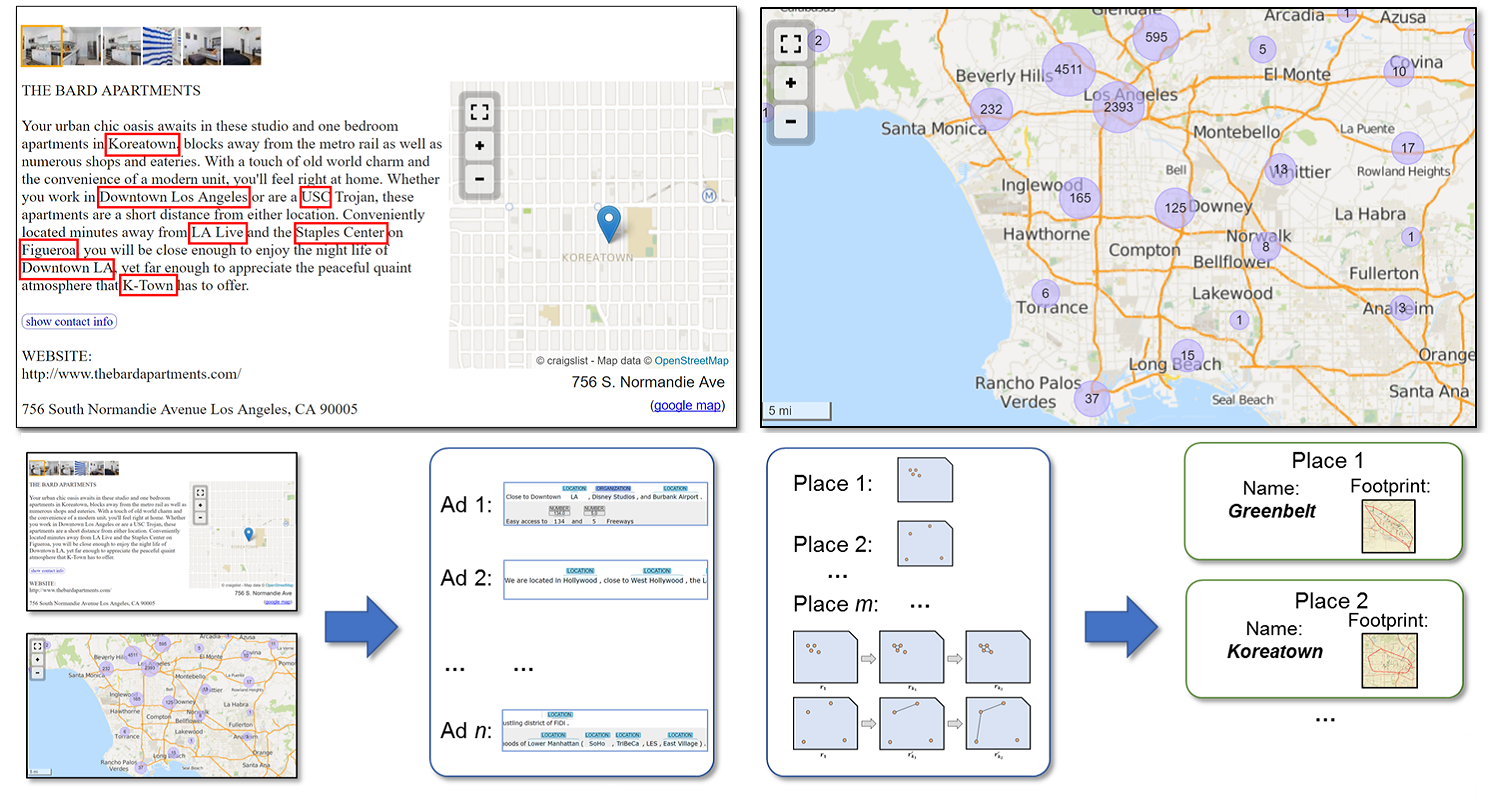
Harvesting Local Place Names
Related paper
Local place names are frequently used by local residents under various contexts, such as during a natural disaster. Such place names may not be recorded in existing gazetteers.
In this work, we propose a computational framework for harvesting local place names from geotagged housing posts. We make use of those posts on local-oriented websites,
where local place names are often mentioned. The proposed framework consists of two stages: natural language processing (NLP) and multi-scale geospatial clustering.
Code: https://github.com/YingjieHu/LocalPlaceName
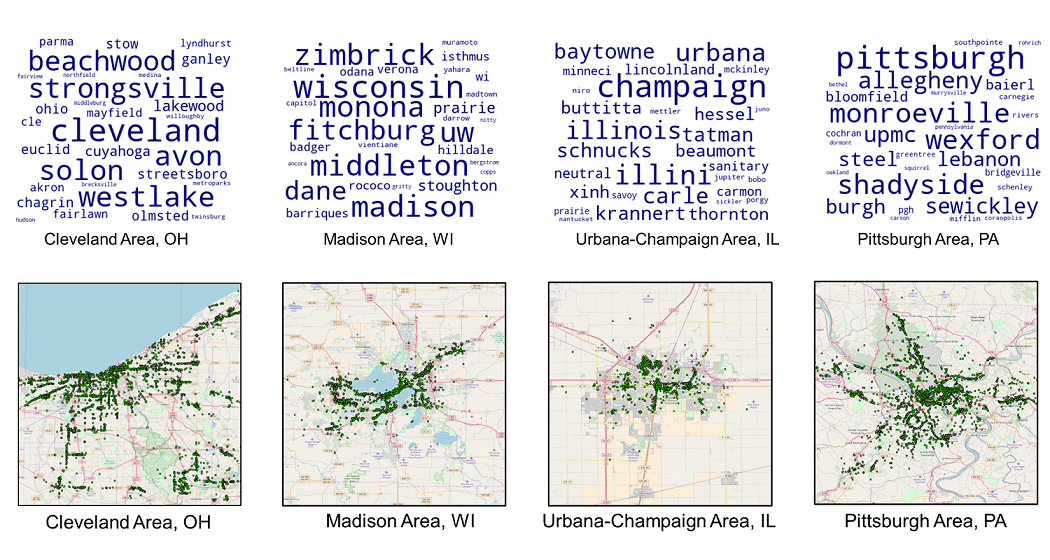
Place Names and Points of Interest (POIs)
Related paper
In this project, we conduct an empirical study based on 112,071 POIs in seven US metropolitan areas extracted from an open Yelp dataset. We propose to adopt term frequency
and inverse document frequency in geographic contexts to identify local terms used in POI names and to analyze their usages across different POI types. Our results show an uneven usage of
local terms across POI types. We also examine the
decaying effect of POI name similarity with the increase of distance among POIs.
Code: https://github.com/YingjieHu/POI_Name
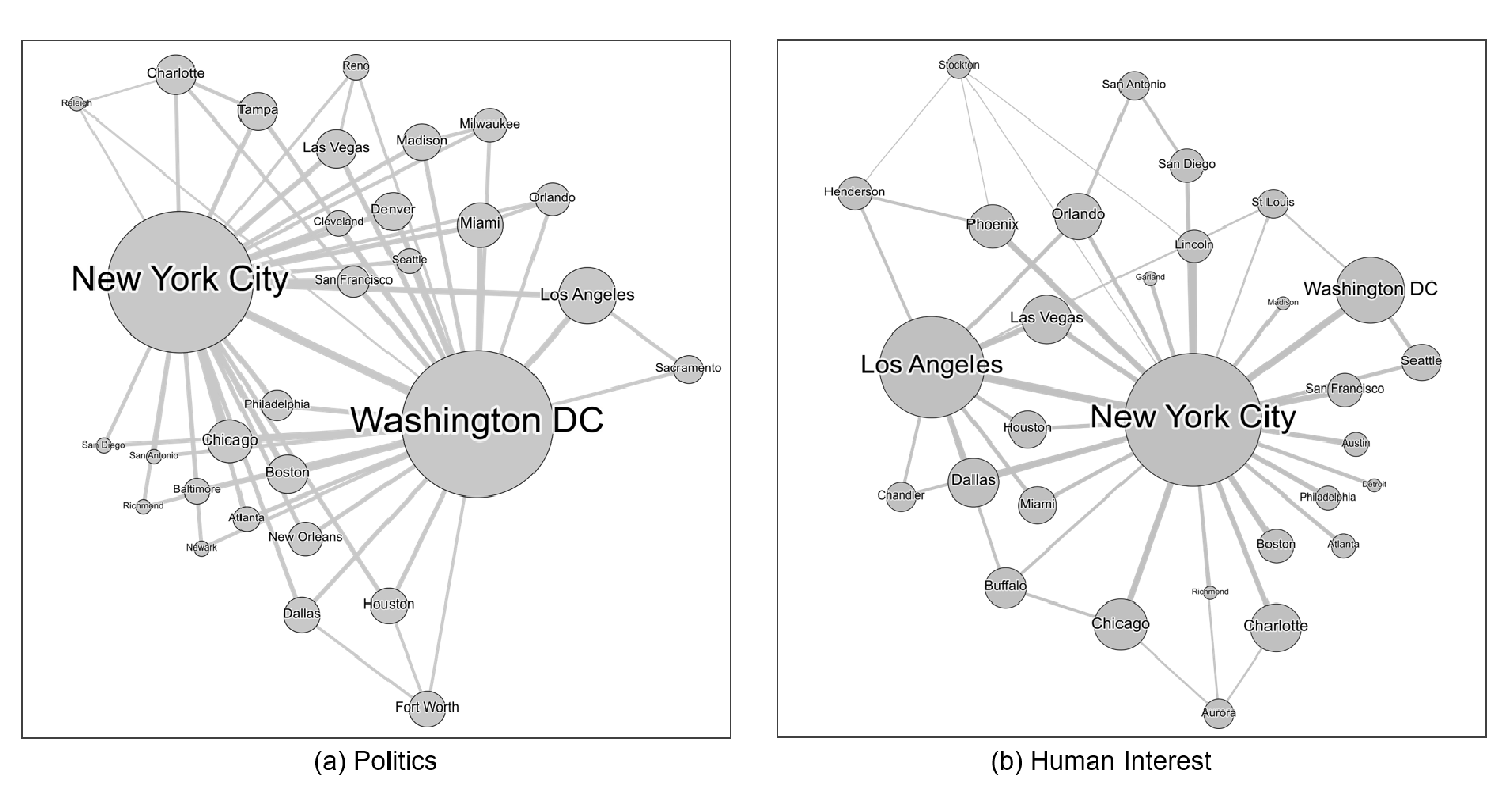
Semantic Relatedness between Cities
Related paper
This project develops a topic modeling based workflow for extracting semantic relatedness between cities from
news articles. News articles contain a rich amount of information about cities and their relations.
The developed workflow makes use of city co-occurrences in news articles, and employs
a topic model, LLDA, to analyze the full texts of news articles and to extract city relatedness.
The extracted semantic relatedness can contribute to applications such as urban planning and GIR.
Code: https://github.com/YingjieHu/CityRelatednessViaNews
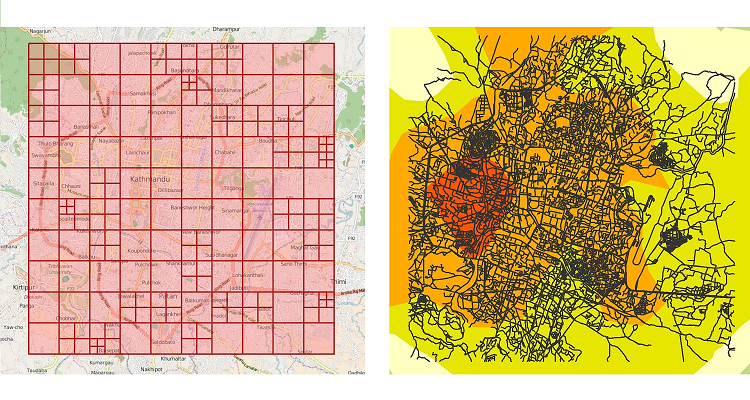
Information Value for Disaster Response
Related paperIn recent years, online volunteers have played important roles in disaster responses by mapping the disaster-affected areas based on remote sensing images. Typically, the disaster-affected area is divided into a number of cells using a grid-based tessellation. Online volunteers can then select a grid cell to start the mapping task. While such an approach coordinates the efforts from many volunteers, it does not differentiate the priorities of the different cells. In this research, we propose an analytical framework based on information value theory which can prioritize the grid cells based on the value of road network information contained in these cells.
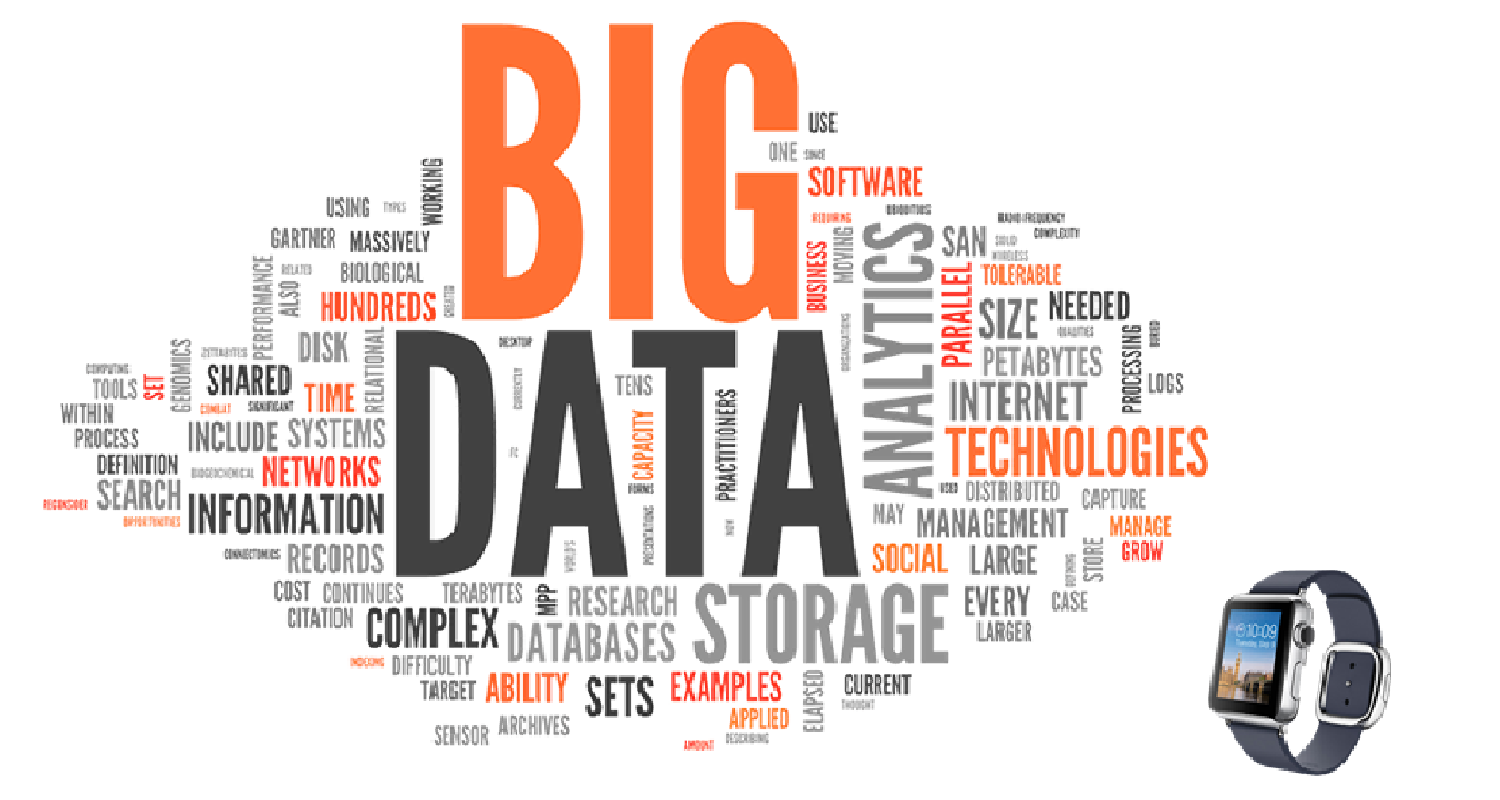
Information Value and Time Geography
Related paperWhile we have access to an increasing amount of information, the newly invented mobile devices, such as smart watches, are often equipped with only small screens. The limited display space restricts the number of information items that can be displayed at each time. Which information should be displayed first? Should it be the weather information, information about traffic conjestions, flight arrival information, meeting schedule, or some others? This work proposes an analytical framework which integrates information value theory with space-time prisms, and quantifies the value of information based on its spatiotemporal impact on the tasks of an individual.
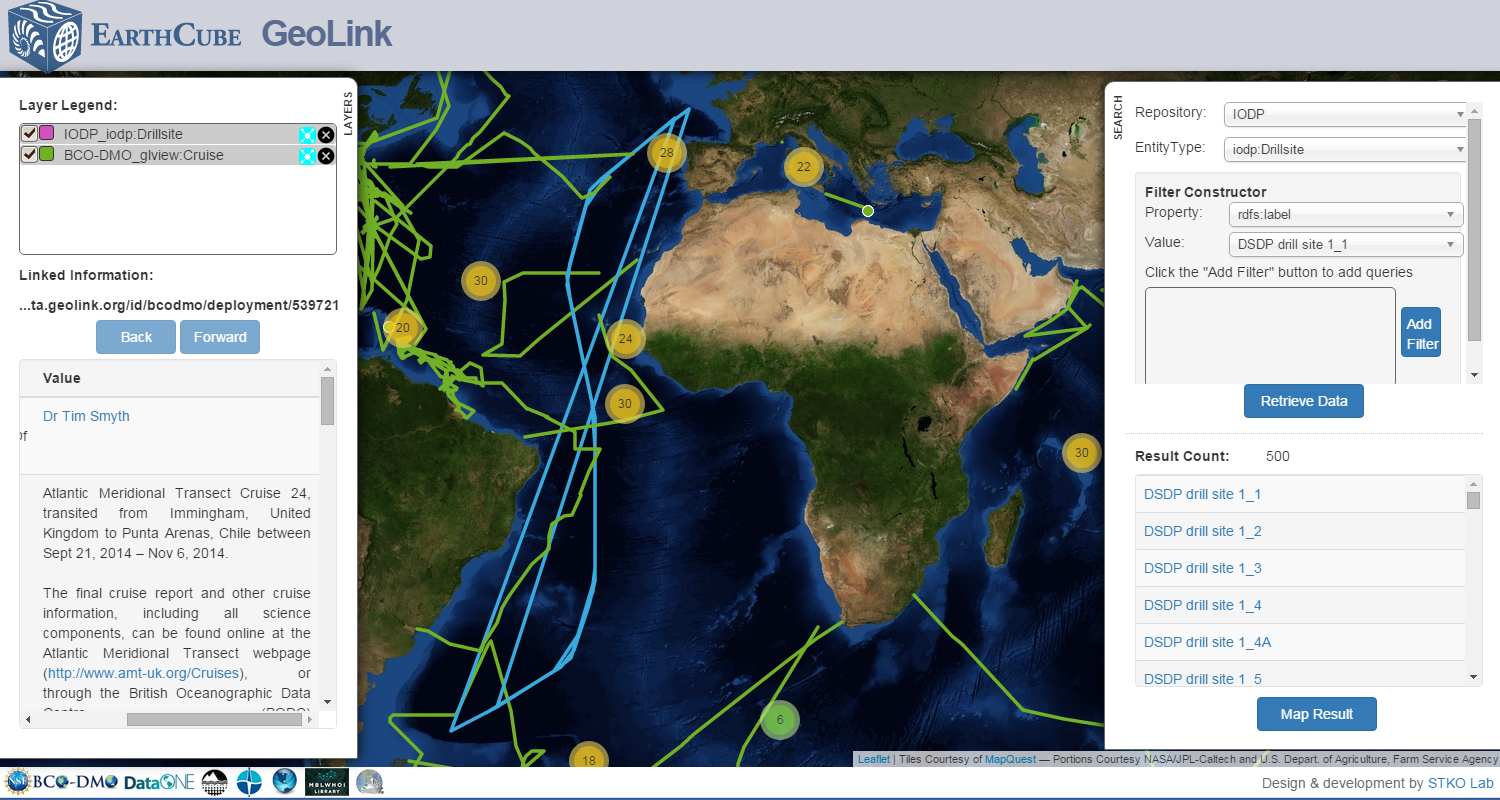
NSF GeoLink and EarthCube
Related paper
GeoLink is a building block project in the NSF EarthCube program. It leverages the Semantic Web technologies to harmonize and link separate data repositories in geoscience. Seven data repositories (e.g., BCO-DMO and DataONE) have
joined this project so far. Modular ontologies have been developed to link the heterogenous data, and a user interface has been designed which allows users to explore the data as tabular forms, maps, and graphs.
URL: http://demo.geolink.org/
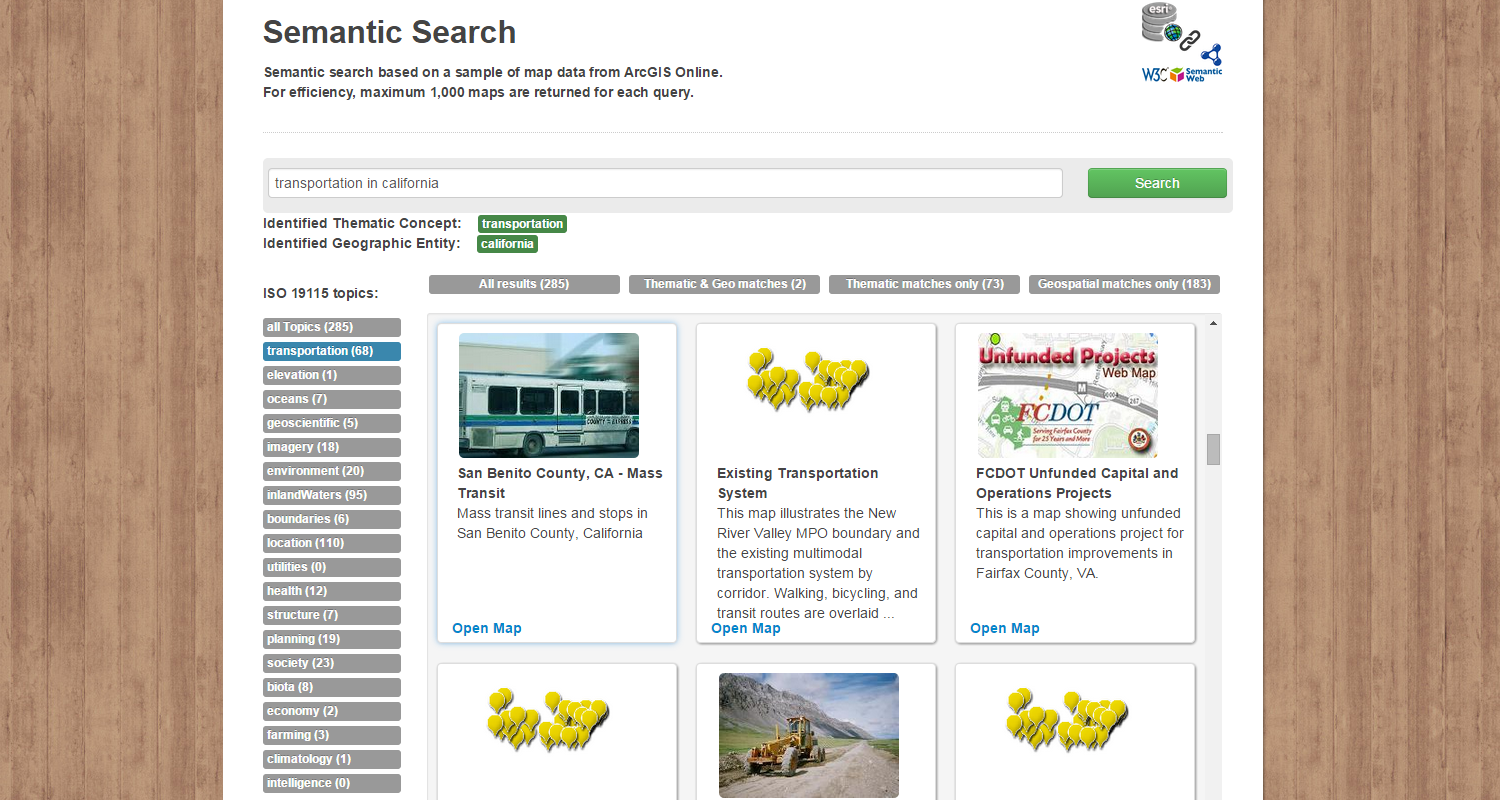
Semantic Search and Metadata Enrichment
Related paper
This project harmonizes the heterogenous metadata in a geoportal based on the ISO 19115 standard. A natural language processing model, Labeled Latent Dirichlet Allocation (LLDA), has been trained based on the metadata from data.gov.
The trained LLDA model is then applied to the user-contributed ArcGIS Online data to harmonize the heterogenous metadata. Multiples tabs have been designed which can display the results in each topic.
URL: http://stko-exp.geog.ucsb.edu/linkedportal/
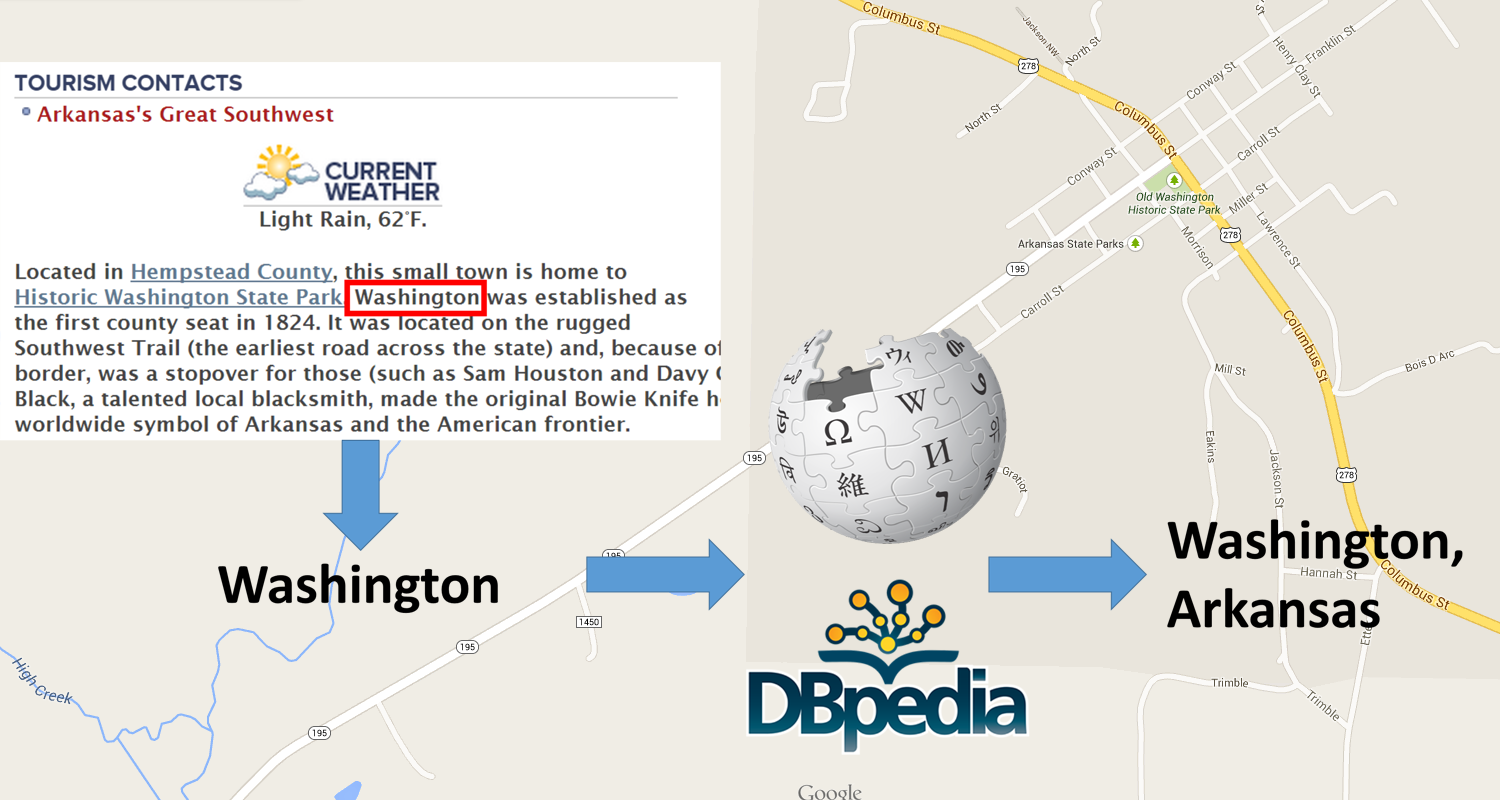
Place Name Disambiguation
Related paper
This project aims to understand the semantics of place names and improve the accuracy of place name disambiguation in short texts. Wikipedia is a data source that has been frequently employed as ground truth descriptions. However, Wikipedia articles do not
emphasize the terms which represent important entities. We combine the entities from DBpedia (the semantic web version of Wikipedia) and designed a co-occurance model to improve the disambiguation result.
Code: https://github.com/YingjieHu/Place-Disambiguation
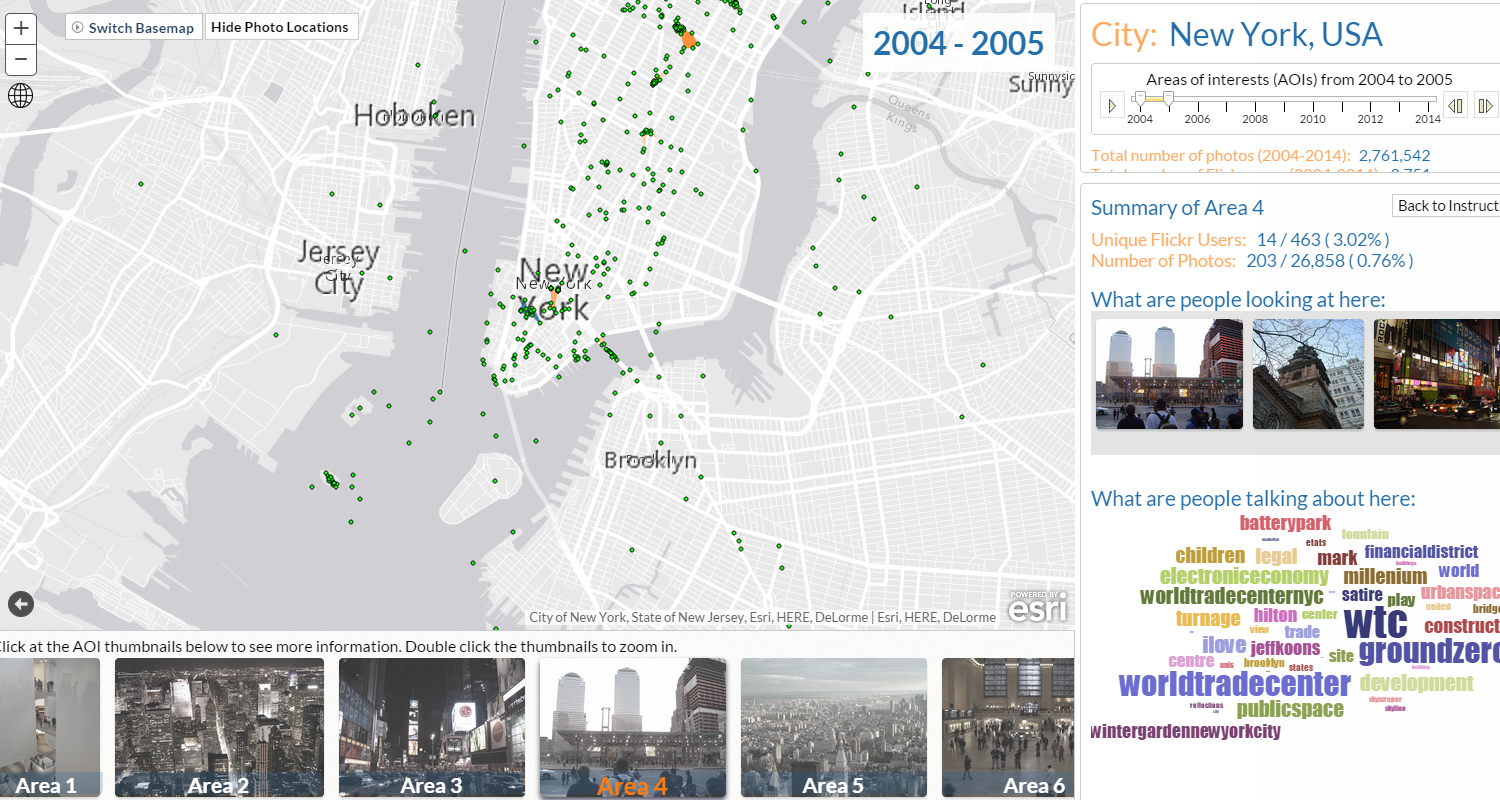
Urban Areas of Interest
Related paper
This project uses geo-tagged Flickr photo data to discover the areas of interest (AOI) within a city. Flickr data from six different cities in the past 10 years have been used for this study.
Clusters have been identified at locations where most people took photos. We detect clusters using DBSCAN, and construct polygons using the chi-shape algorithm.
In order to understand the semantics of the extracted AOIs, we also extract the distinctive tags and representative photos within these areas.
URL: http://stko-exp.geog.ucsb.edu/urbanAOIs/index.html
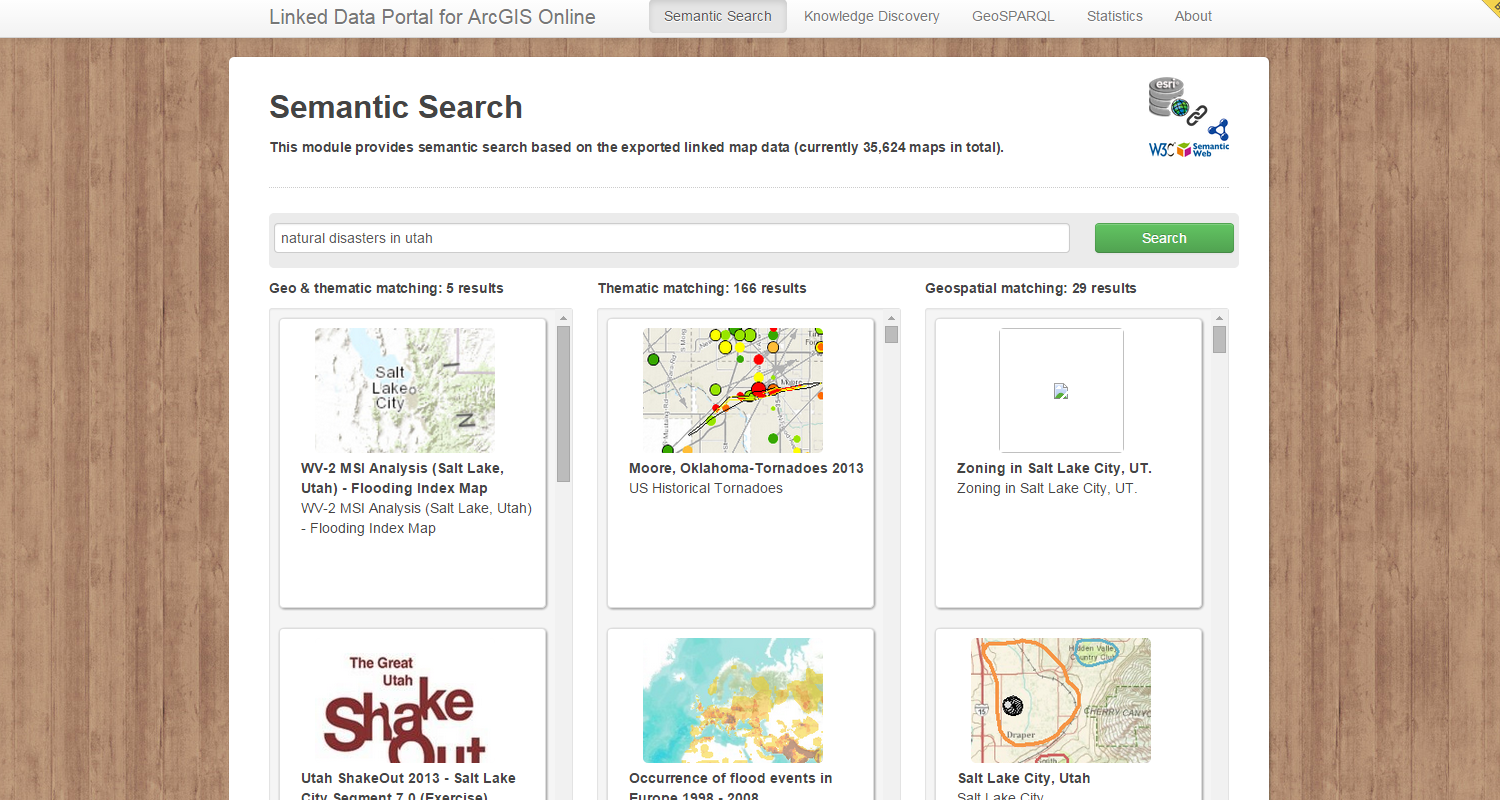
Semantic Search for ArcGIS Online
Related paper
We enable semantic search for maps by expanding an input query with related thematic concepts and geographic terms. Related thematic concepts are identified
using Latent Semantic Analysis (LSA) and WordNet. Related geographic entities are found using a gazetteer Geonames.
URL: http://stko-exp.geog.ucsb.edu/linkedarcgis/
Video: http://www.youtube.com/watch?v=38ssyXaP7v0
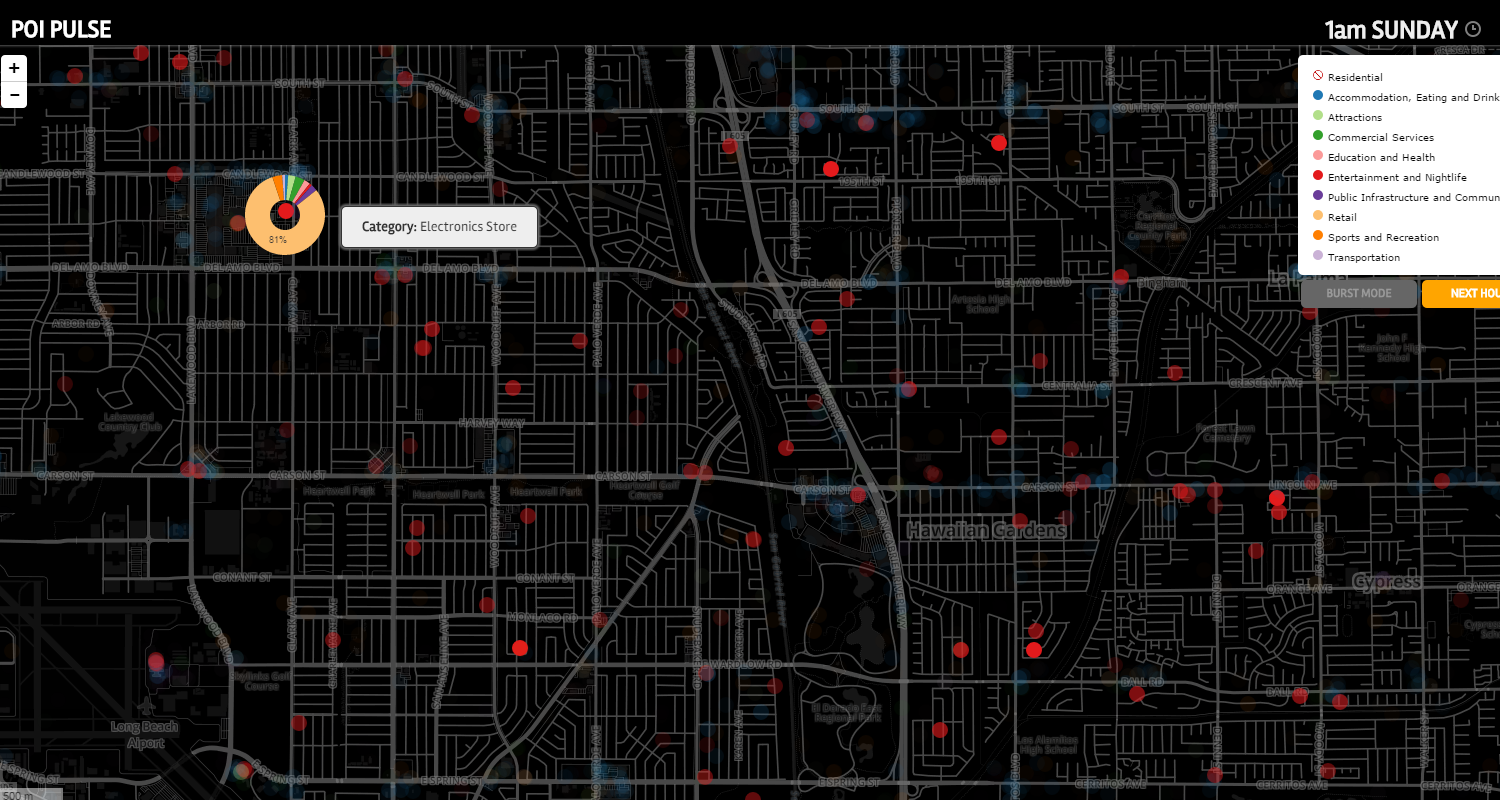
Point of Interest (POI) Pulse
Related paper
This project reclassifies the categories of Point of Interest (POIs) from Foursquare using support vector machine. One POI is classified into multiple categories based on
its spatial, temporal, and thematic characteristics. We visualize a large amount of POI data using HTML5 and javascript, and discovered a tipping point to switch between vector and raster representations. This project
also enables one to explore the dynamics or pulse of a city by visualing real-time user activities on Foursquare.
URL: http://stko-poi.geog.ucsb.edu/prod/lapulse/
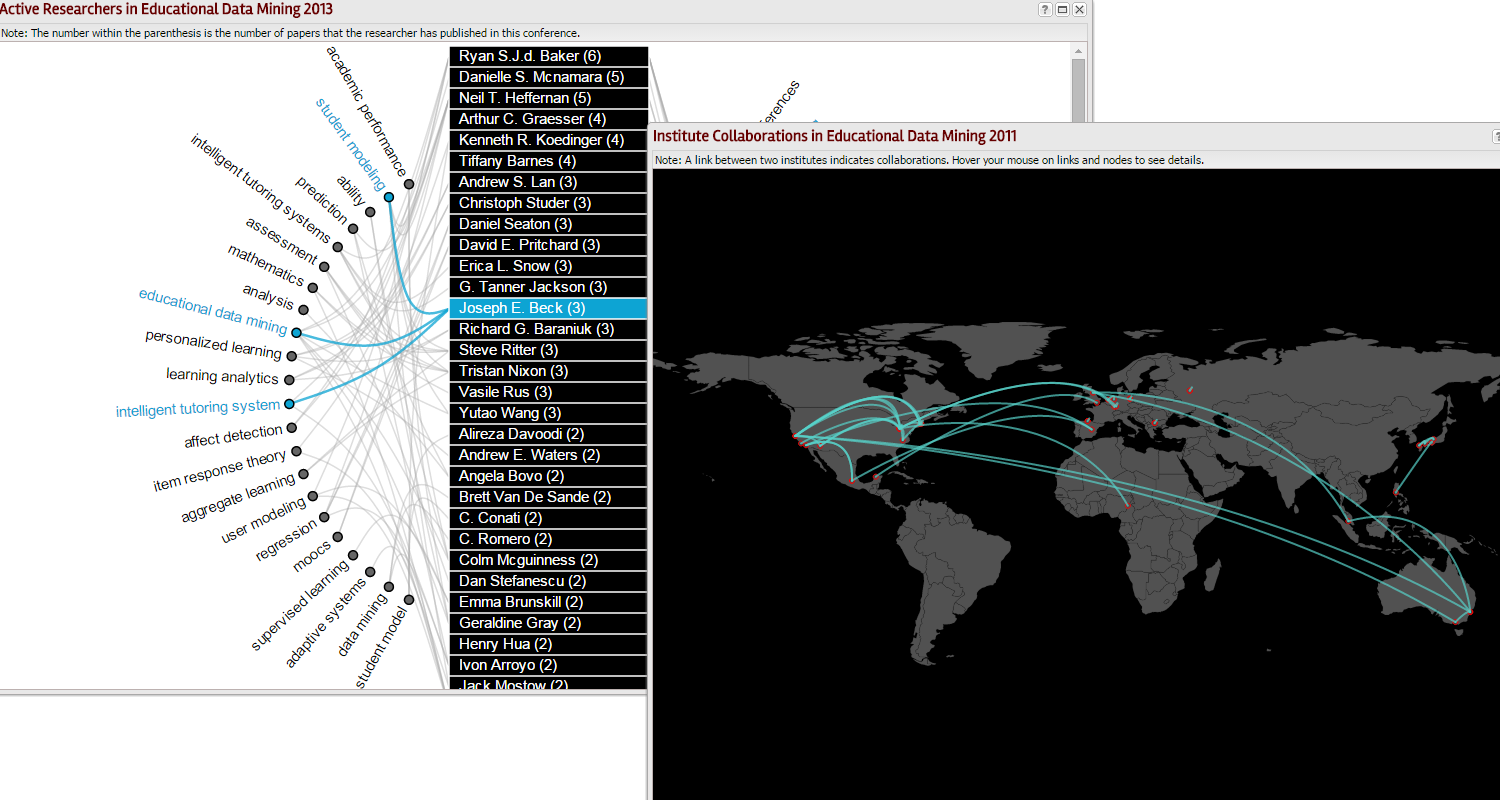
Scientometrics Portal for Learning Analytics
Related paper
This is a project developed for the Learning Analytics and Knowledge (LAK) Challenge. We make use of the LAK community's publication data, and visualize the geographic collaboration patterns, coauthor networks, and
citation distributions of academic papers. We have also designed a tool for reviewer recommendation. We won the Second Prize Award in this LAK Challenge.
URL: http://stko-exp.geog.ucsb.edu/lak/
Video: http://www.youtube.com/watch?v=g_Bsm_fEJkA

Semantic Web Journal Portal
Related paper
A project for the Semantic Web Journal to improve the analysis of the journal’s publication data, including the number of publications, citations for each author. Analysis results are
then visualized using techniques such as D3.
URL: http://semantic-web-journal.com/SWJPortal/
Video: http://www.youtube.com/watch?v=LPWVfLaC6Co
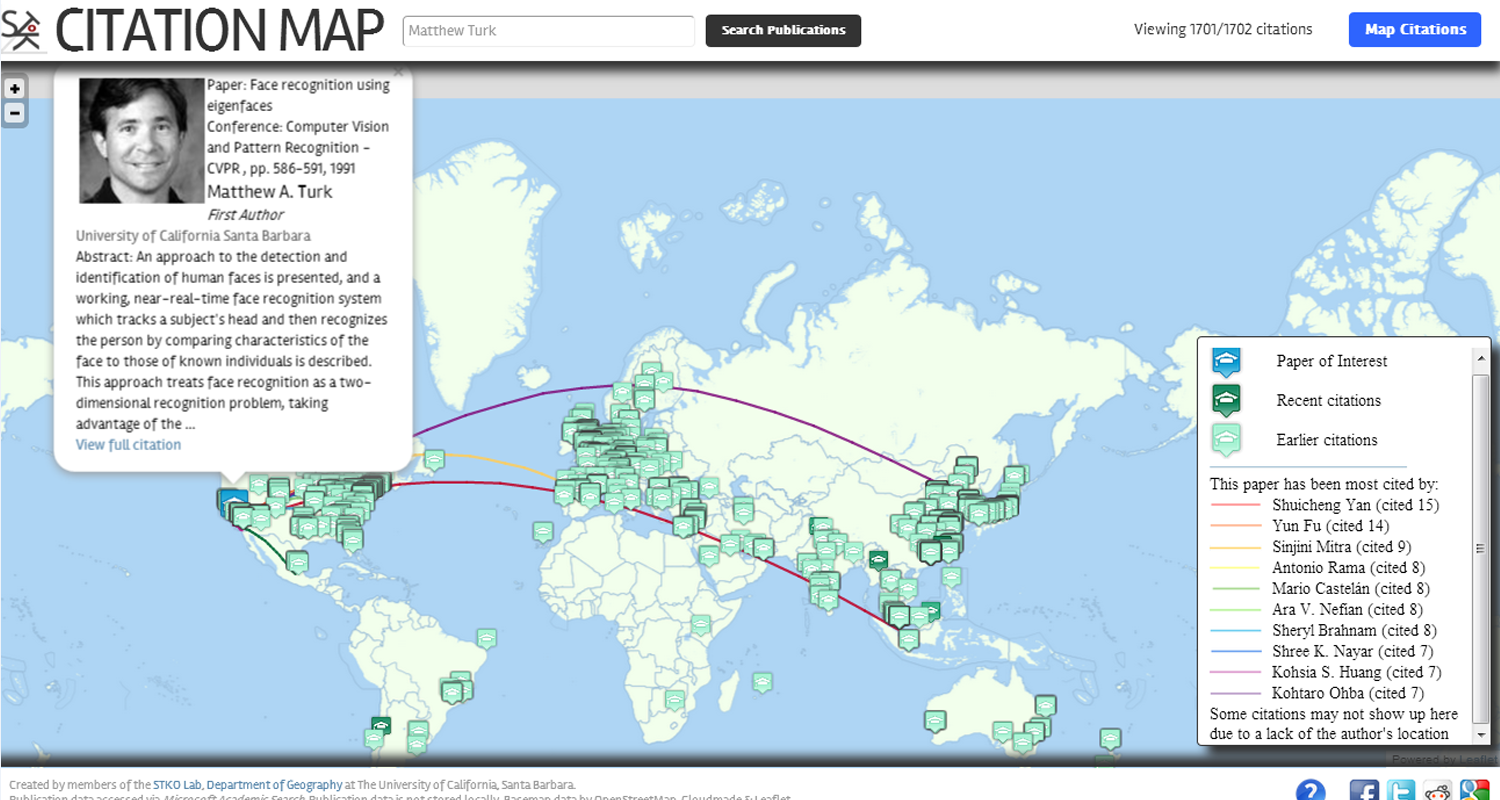
Citation Map
Related paper
A project for the AAG Mashup Competition that visualizes the citation data on a global scale map. This application locates the first author of a paper, and then searches all researchers who have cited
this paper in their work. Finally, the locations of these researchers are visualized on a map. We won the Finalist Award.
URL: http://stko-work.geog.ucsb.edu:8080/map/
Video: http://www.youtube.com/watch?v=eC309dGdJM0

Space-Time Contexts for File Management
Related paper
This project proposes to augment file management systems with space-time contexts, so that locations and time are attached to digital files that we use everyday on laptops, smartphones, and other mobile devices. Such addtional indices allow users to search files based on not only traditional folder hierachies but also the space-time contexts in which files have been used.
For example, finding a document you opened in Washington DC during a conference last month.
Videos: https://www.youtube.com/watch?v=qFhPhj5gObI
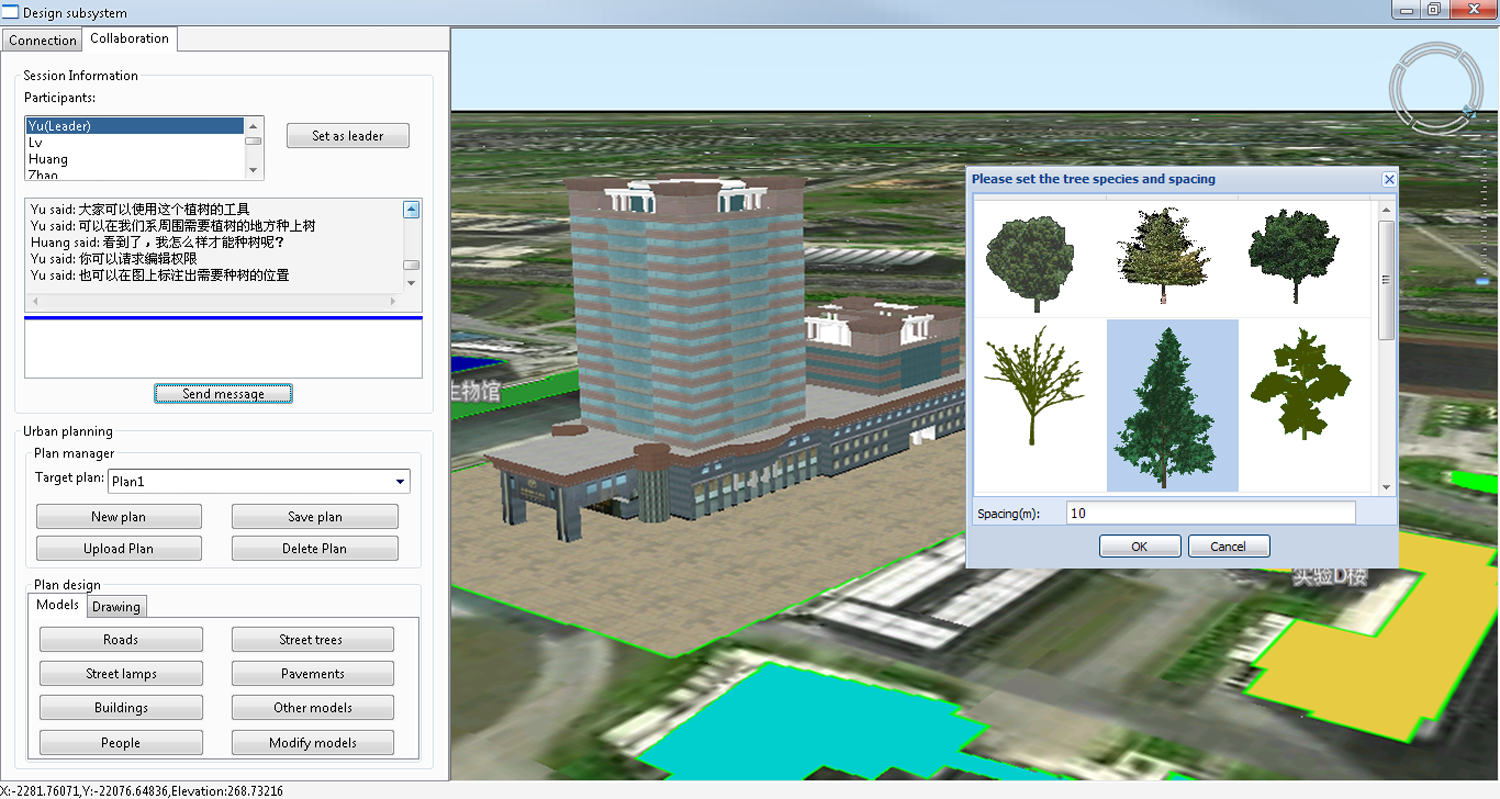
3D GIS for Public Participation
Related paper
This system supports the collaborations of participants in different stages of decision making in contexts such as urban planning. Participants can not only provide comments
and feedbacks on existing plans, but also engage in intensive discussions and real-time design. This system integrates the concept of GeoDesign and helps to answer the "what if" questions in many applications.
Code: https://github.com/YingjieHu/PPGIS
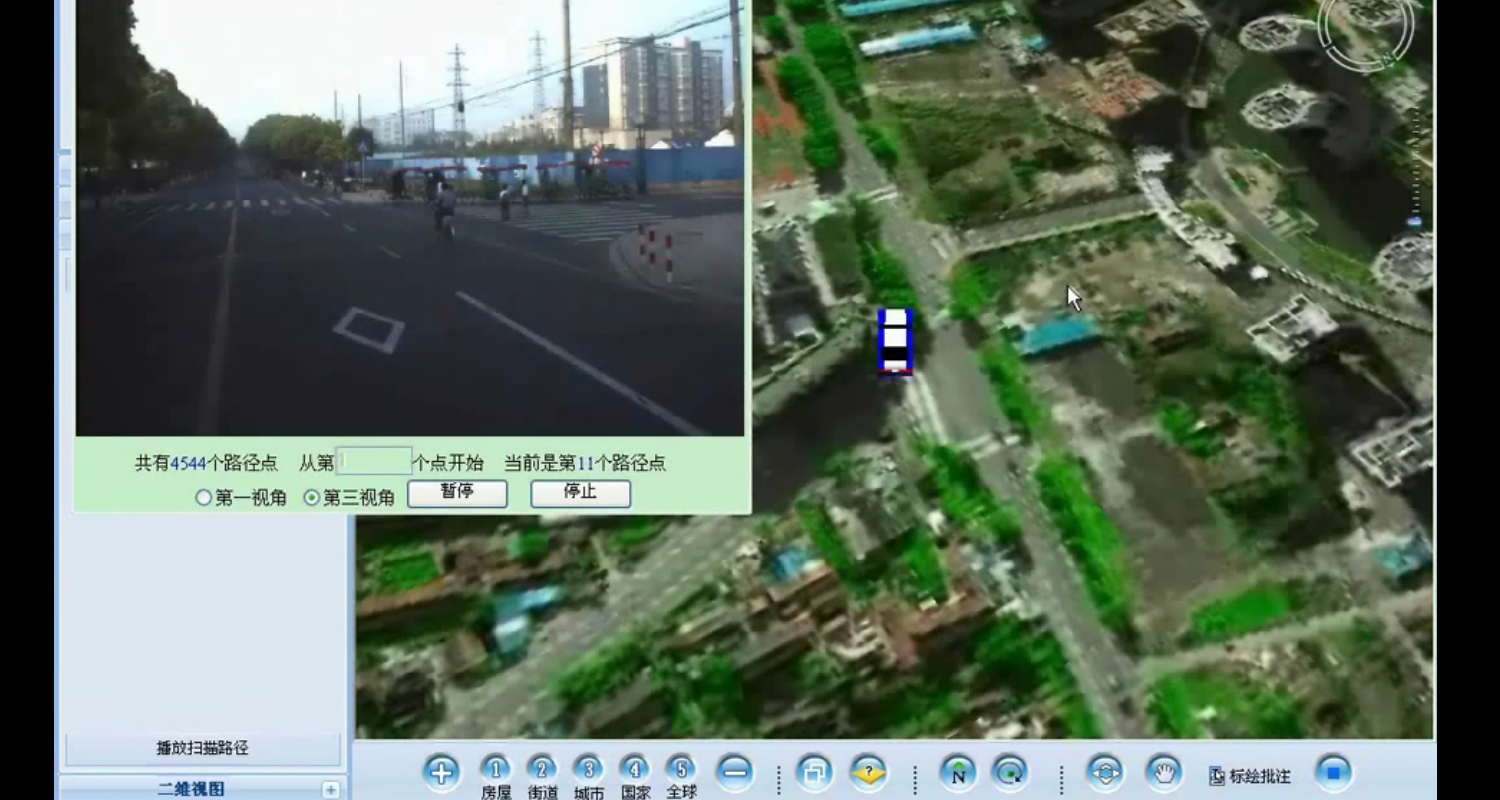
3D GIS for Agricultural Management
A 3D GI system developed for Chongming, Shanghai, China. This system has been designed to provide local farmers with easy access to agricultural information and help them better manage their lands and crops.
Video: https://www.youtube.com/watch?v=LifF-0Rghtg

3D GIS for Pollution Mornitoring
A 3D GI system developed for pollution mornitoring in Shanghai, China. This system was designed for Shanghai Environmental Protection Agency (EPA) to help manage the information about
electricity and sewage plants. Alerts will be issued when real-time pollution exceeds a threshold level.
Video: https://www.youtube.com/watch?v=wiuJLIOrXqI
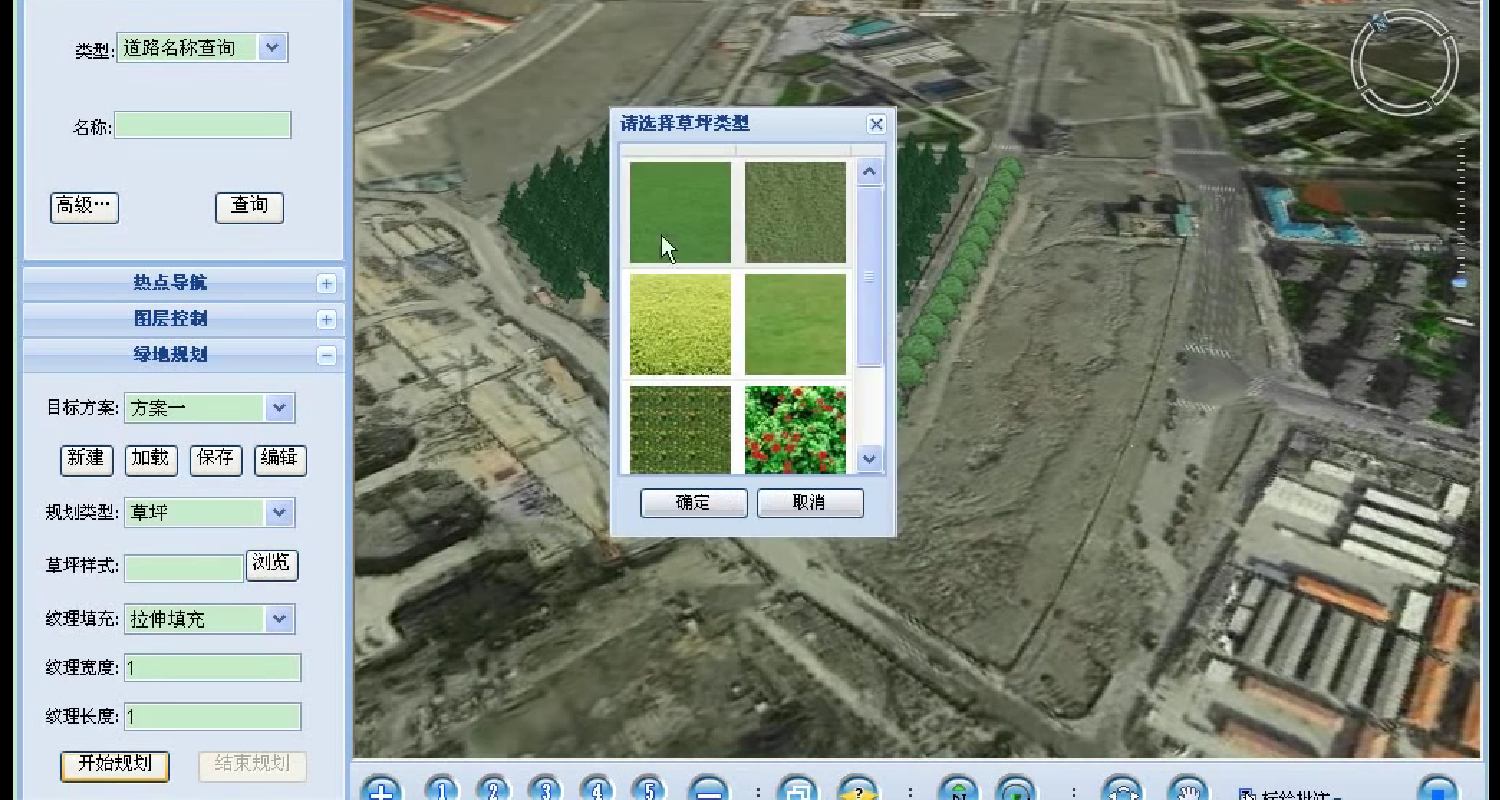
3D GIS for Greenspace Planning
A 3D GI system developed for planning greenspace in Shanghai, China. This system allows users to plan the greenspace in different ways by choosing grass types and tree species. It then visualizes the possible results to the users.
Video: https://www.youtube.com/watch?v=ATphYE3NPQQ
Teaching
Courses Taught at UB:
- GEO 281: Web-based GIS
- GEO 481/506: Geographic Information Systems
- GEO 414/514: GIS and Machine Learning
- GEO 503: AI for Geospatial Applications
Courses Taught at UTK:
- GEOG 411: Intermediate Geographic Information Science
- GEOG 414: Geodatabase and Spatial Data Management
- GEOG 509: Geospatial Semantics
Courses Taught at UCSB:
- GEOG 12: Maps and Spatial Reasoning
- GEOG 176A: Introduction to Geographic Information Science
- GEOG 176B: Technical Issues in GIS
- GEOG 176C: GIS Project Management
Service
Peer Reviewer for Academic Journals
- International Journal of Geographical Information Science
- Transactions in GIS
- Cartography and Geographic Information Science
- Annals of the American Association of Geographers
- Computers, Environment and Urban Systems
- International Journal of Disaster Risk Reduction
- Science of The Total Environment
- Health & Place
- Social Science & Medicine
- Environment and Planning B: Urban Analytics and City Science
- Landscape and Urban Planning
- Cities
- International Journal of Digital Earth
- International Journal of Remote Sensing
- Journal of Spatial Information Science
- International Journal of Applied Earth Observation and Geoinformation
- Journal of Spatial Science
- Environmental Impact Assessment Review
- Computers and Electronics in Agriculture
- Professional Geographer
- Scientific Reports
- BMC Public Health
- PLOS ONE
- Patterns- Cell Press
- IEEE Access Journal
- ACM Transactions on Intelligent Systems and Technology
- ACM Transactions on Spatial Algorithms and Systems
- Applied Energy
- Data & Knowledge Engineering
Committee Service
- Program Committee Member, 2025 International Conference on Geographic Information Science (GIScience), August 26-29, 2025, Christchurch, New Zealand.
- Academic Director and BOD Member, AAG Geographic Information Science and Systems (GISS) Specialty Group, 2024-2025.
- Lead Organizer, 2025 AAG Symposium on GeoAI and Deep Learning in Geospatial Research, Mar. 24-28, 2025, Detroit, Michigan, USA.
- Program Committee Member, ACM SIGSPATIAL International Workshop on GeoAI: AI for Geographic Knowledge Discovery, Oct. 29, 2024, Atlanta, Georgia, USA.
- Program Committee Member, I-GUIDE Forum 2024: Convergence Science and Geospatial AI for Environmental Sustainability, Oct. 14-16, 2024, Jackson, Wyoming, USA.
- Lead Organizer, 2024 AAG Symposium on GeoAI and Deep Learning in Geospatial Research, April 16-20, 2024, Honolulu, Hawaii, USA.
- Program Committee Member, 2024 CaGIS + UCGIS Symposium, June 3-6, 2024, Columbus, Ohio, USA.
- Program Committee Member, 2024 International Conference on Spatial Information Theory (COSIT), September 17-20, 2024, Québec City, Canada.
- Program Committee Member, Geographic Information Extraction from Texts (GeoExT), March 24-28, 2024, Glasgow, Scotland.
- Program Committee Member, ACM SIGSPATIAL International Workshop on GeoAI: AI for Geographic Knowledge Discovery, Nov. 13-16, 2023, Hamburg, Germany.
- Program Chair, 2023 Spatial Data Science Symposium, Sept. 5-6, 2023, virtual.
- Lead Organizer, 2023 AAG Symposium on GeoAI and Deep Learning in Geospatial Research, Mar. 23-27, 2023, Denver, USA.
- Program Committee Member, 12th International Conference on Geographic Information Science, Sep. 13-15, 2023, Leeds, UK.
- Guest Editor, Methods in Geo-Knowledge Graph and GeoAI, Transactions in GIS, 2021-2022.
- Program Committee Member, 2022 International Conference on Spatial Information Theory (COSIT), Sep. 5-9, 2022, Kobe, Japan.
- Guest Editor, Geospatial Artificial Intelligence, GeoInformatica, 2021-2022.
- Research Committee Member, UCGIS Research Committee, 2019-2022.
- Co-Chair, 2021 ACM SIGSPATIAL Workshop on GeoAI: AI for Geographic Knowledge Discovery, Nov. 2, 2021, Beijing, China.
- Program Committee Member, KDD 2021 workshop on Data-driven Humanitarian Mapping, Aug. 14, 2021, Online.
- Program Committee Member, 2021 ACM SIGSPATIAL Conference, Nov. 2-5, 2021, Beijing, China.
- Program Committee Member, 2021 ACM SIGSPATIAL Geospatial Humanities Workshop, Nov. 2, 2021, Beijing, China.
- Senior Program Committee Member, 2021 International Conference on Geographic Information Science, Sept. 15-18, 2021, Poznań, Poland.
- Program Committee Member, 2020 ACM SIGSPATIAL Conference, Nov. 3-6, 2020, Seattle, USA.
- Lead Organizer, 2020 AAG Symposium on GeoAI and Deep Learning in Geospatial Research, Apr. 6-10, 2020, Denver, USA.
- Senior Program Committee Member, 2020 International Semantic Web Conference, Nov. 2-6, 2020, Athens, Greece.
- Program Committee Member, 2020 ACM SIGSPATIAL Geospatial Humanities Workshop, Nov. 3, 2020, Seattle, USA.
- Co-Chair, 2019 ACM SIGSPATIAL Workshop on GeoAI: AI for Geographic Knowledge Discovery, Nov. 5, 2019, Chicago, USA.
- Program Committee Member, 2019 ACM SIGSPATIAL Conference, Nov. 5-8, 2019, Chicago, USA.
- Program Committee Member, 2019 International Conference on Spatial Information Theory (COSIT), Sept. 9-13, 2019, Regensburg, Germany.
- Lead Organizer, 2019 AAG Symposium on GeoAI and Deep Learning in Geospatial Research, Apr. 3-7, 2019, Washington DC, USA.
- Chair, 2018 ACM SIGSPATIAL Workshop on GeoAI: AI for Geographic Knowledge Discovery, Nov. 6, 2018, Seattle, USA.
- Guest Editor, GeoAI: Artificial Intelligence Techniques for Geographic Knowledge Discovery, IJGIS, 2018.
- Paper Co-Chair, 9th Workshop on Ontology Design and Patterns, Oct. 9, 2018, Monterey, USA.
- Lead Organizer, 2018 AAG Symposium on GeoAI and Deep Learning in Geospatial Research, 2018, New Orleans, USA.
- Member, AAG Geographic Information Science and Systems (GISS) Specialty Group, 2016-2018.
- BOD Member, Chinese Professional in Geographic Information Systems, 2018-2019.
- Program Committee Member, Location Privacy and Security Workshop, 2018.
- General Co-Chair, 2017 ACM SIGSPATIAL Workshop on GeoAI: AI for Geographic Knowledge Discovery, Nov. 7, 2017, Los Angeles, USA.
- Program Committee Member, 27th International World Wide Web Conference, Apr. 23-27, 2018, Lyon, France.
- Program Committee Member, 9th International Conference on Knowledge Capture, Dec. 4th-6, 2017, Austin, USA.
- Organization Committee Member, Workshop on Geo-Knowledge Graphs, Sep. 4, 2017, L’Aquila, Italy.
- Program Committee Member, 16th International Semantic Web Conference, Oct. 21-25, 2017, Vienna, Austria.
- Program Committee Member, 8th Workshop on Ontology Design and Patterns, Oct. 21, 2017, Vienna, Austria.
- Program Committee Member, 7th Workshop on Ontology and Semantic Web Patterns, Oct. 17, 2016, Kobe, Japan.
- Program Committee Member, 6th Workshop on Ontology and Semantic Web Patterns, Oct. 11, 2015, Bethlehem, USA.
- Program Committee Member, 29th AAAI Conference on Artificial Intelligence, Jan. 25-30, 2015, Austin, USA.
- Program Committee Member, 19th Conference on Knowledge Engineering and Knowledge Management, Nov. 24-28, 2014, Linköping, Sweden.
- Local Organizer, GeoVoCamp Series, 2012, 2013, 2014, 2015, Santa Barbara, USA.
Memberships of Professional Associations
- American Association of Geographers (AAG)
- American Geophysical Union (AGU)
- Association for Computing Machinery (ACM) SIGSPATIAL
- Cartography and Geographic Information Society (CaGIS)
- International Association of Chinese Professionals in Geographic Information Sciences (CPGIS)
- Sigma Xi, The Scientific Research Honor Society
Awards
- UCGIS Community Champion, by University Consortium for Geographic Information Science (UCGIS) and NSF I-GUIDE Program, 2025
- UCGIS Early/Mid-Career Research Award, by University Consortium for Geographic Information Science (UCGIS), 2024
- AAG SAM Emerging Scholar Award, by AAG Spatial Analysis & Modeling (SAM) Specialty Group, 2024
- CPGIS Young Scholar Award, by International Association of Chinese Professionals in Geographic Information Sciences (CPGIS), 2023
- UB Exceptional Scholar: Young Investigator Award, by University at Buffalo, 2022
- Finalist of the Best Full Paper Award, by GIScience Conference Organization Committee, 2021
- Global Young Scientist Award, by World Geospatial Developers Conference (WGDC), 2021
- Waldo-Tobler GIScience Young Researcher Award, by Austrian Academy of Sciences, 2020
- Best GIScience Full Paper Award, by GIScience Conference Organization Committee, 2018
- Professional and Scholarly Development Award, by the University of Tennessee Knoxville, 2017
- CaGIS Doctoral Scholarship, by the Cartography and Geographic Information Society, 2016
- Geography Excellence in Research Award, by UCSB Geography, 2016
- CESASC Scholarship Award, by Chinese-American Engineers and Scientists Association, 2016
- National Award for Outstanding Chinese Students Studying Abroad, by China Scholarship Council, 2015
- Graduate Dissertation Fellowship, by UCSB Graduate Division, 2015
- Early Career Scholar Travel Grant, by NSF EarthCube Program, 2015
- Graduate Travel Grant, by UCSB Graduate Division, 2015
- International Geographic Information Fund Award, by the Association of American Geographers, 2015
- Graduate Travel Grant, by UCSB Graduate Student Association, 2015
- Graduate Dissertation Fellowship, by UCSB Affiliates, 2014
- 2nd Prize for Learning Analytics and Knowledge (LAK) Data Challenge, by the LAK Challenge Organization Committee, 2014
- Jack Dangermond Graduate Fellowship, by UCSB Geography, 2013
- Finalist Prize for AAG Robert Raskin Mashup Mapping Competition, by the Competition Organization Committee, 2013
- Jack Dangermond Travel Award, by UCSB Geography, 2012, 2013, 2014, 2015
- NSF Travel Award for the 20th ACM SIGSPATIAL conference, by the Conference Organization Committee, 2012
- NSF Travel Award for the 6th RR Conference, by the Conference Organization Committee, 2012
- Doctoral Scholars Fellowship, by UCSB Geography, 2011
- Excellent Master Thesis, by East China Normal University (ECNU) Geography, 2011
- Graduate Fellowship, by ECNU Geography, 2010, 2011
- Excellent Graduate, by Shanghai Municipal Education Commission, 2008
- Excellent Bachelor Thesis, by ECNU Geography, 2008
- Undergraduate Fellowship, by ECNU Geography, 2005, 2007
Media Coverage
- Encyclopedia Britannica Kids: Ask the experts, Yingjie Hu: An introduction to geospatial technologies and AI
- American Association of Colleges and Universities: Yingjie Hu, University at Buffalo – Can ChatGPT Help First Responders During Disasters
- Channel 2 WGRZ: Study looks at social media's role in connecting the community during the 2022 blizzard
- Buffalo News: Facebook groups saved lives during '22 blizzard. UB studying how they kept communities connected
- NPR Academic Minute: Yingjie Hu, University at Buffalo – Can ChatGPT Help First Responders During Disasters (story on February 22, 2024)
- Emergency Management Magazine: How ChatGPT Could Help First Responders During a Disaster
- Homeland Security News Wire: ChatGPT Could Help First Responders During Natural Disasters
- Science Daily: How ChatGPT could help first responders during natural disasters
- NewsBreezer: ChatGPT improves emergency management by identifying emergency locations via social media data
- Digital Information World: ChatGPT Enhances Emergency Management by Identifying Distress Locations via Social Media Data
- Forbes: Welcome To The Vice Age: How Sex, Drugs And Gambling Help Americans Cope With Covid
- CNN: We really did buy more alcohol during the early pandemic, study finds
- NPR-WBFO: UB study of 16 states confirms, yup, we drank a lot more last year
- Miami Herald: Americans stocked up on alcohol early during COVID, study finds. What did they buy?
- LMTOnline: Study shows COVID-19 impact on booze habits, TX bought more beer
- Thrillist: Americans Did Indeed Buy More Alcohol During the Pandemic
- New Medical: UB researchers analyze pandemic-related shifts in alcohol sales across 16 U.S. states
- UB Now: Two UB faculty receive NSF funding to study social media in disaster response
- UB Now: Field biologists, NASA planes to map biodiversity in South Africa
- UB Now: Researcher explains benefits of using geotagged content in research
- Phys.org: How online neighborhood reviews could aid urban planning
- Smart Cities Dive: A new source of planning data: online reviews
- Planetizen: Study Examines the Benefits of Online Reviews to Planning Research
- IEEE GlobalSpec: Online reviews can help in future urban planning
- GIS Lounge: GIS and Named Entity Recognition: Identifying Geographic Locations in Text
- Reuters: Crowd-sourced maps for natural disasters boosted by new algorithm
- EurekAlert!: UT professor develops algorithm to improve online mapping of disaster areas
- Voice of America (VOA News): New Algorithm Boosts Crowd-sourced Maps for Natural Disasters
- Communications of the ACM: Professor Develops Algorithm to Improve Online Mapping of Disaster Areas
- Phys.org: Team develops algorithm to improve online mapping of disaster areas
- GIS and Science: Metadata Topic Harmonization and Semantic Search for Linked-Data-Driven Geoportals: A Case Study Using ArcGIS Online





